Situation Analysis of Woolworth Group Limited
VerifiedAdded on 2022/11/14
|18
|4446
|433
AI Summary
This report provides a situation analysis of Woolworth Group Limited through PESTEL analysis, SWOT analysis, and competitor analysis. It also discusses the key stakeholders and organization structure using the Mintzberg’s model.
Contribute Materials
Your contribution can guide someone’s learning journey. Share your
documents today.
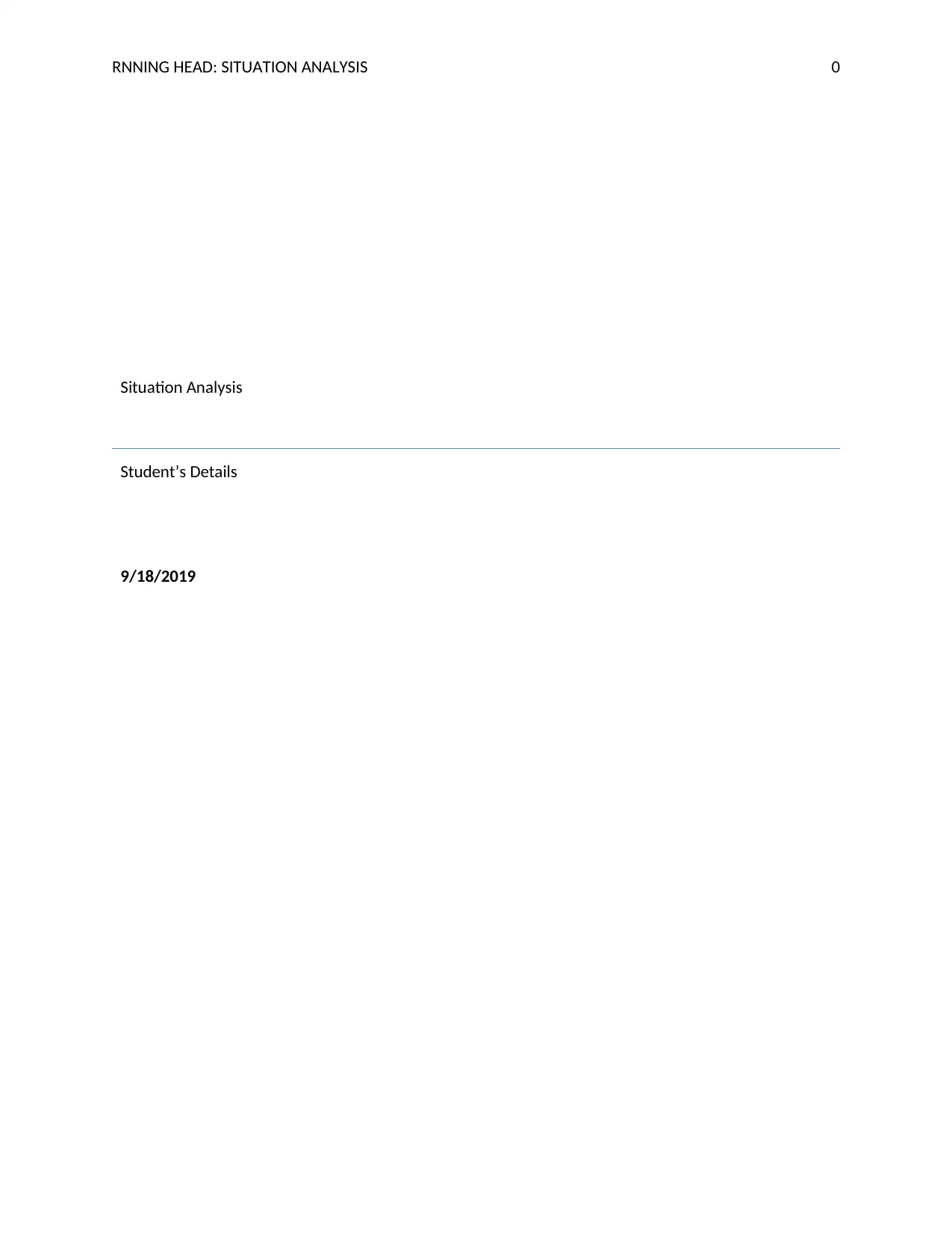
RNNING HEAD: SITUATION ANALYSIS 0
Situation Analysis
Student’s Details
9/18/2019
Situation Analysis
Student’s Details
9/18/2019
Secure Best Marks with AI Grader
Need help grading? Try our AI Grader for instant feedback on your assignments.
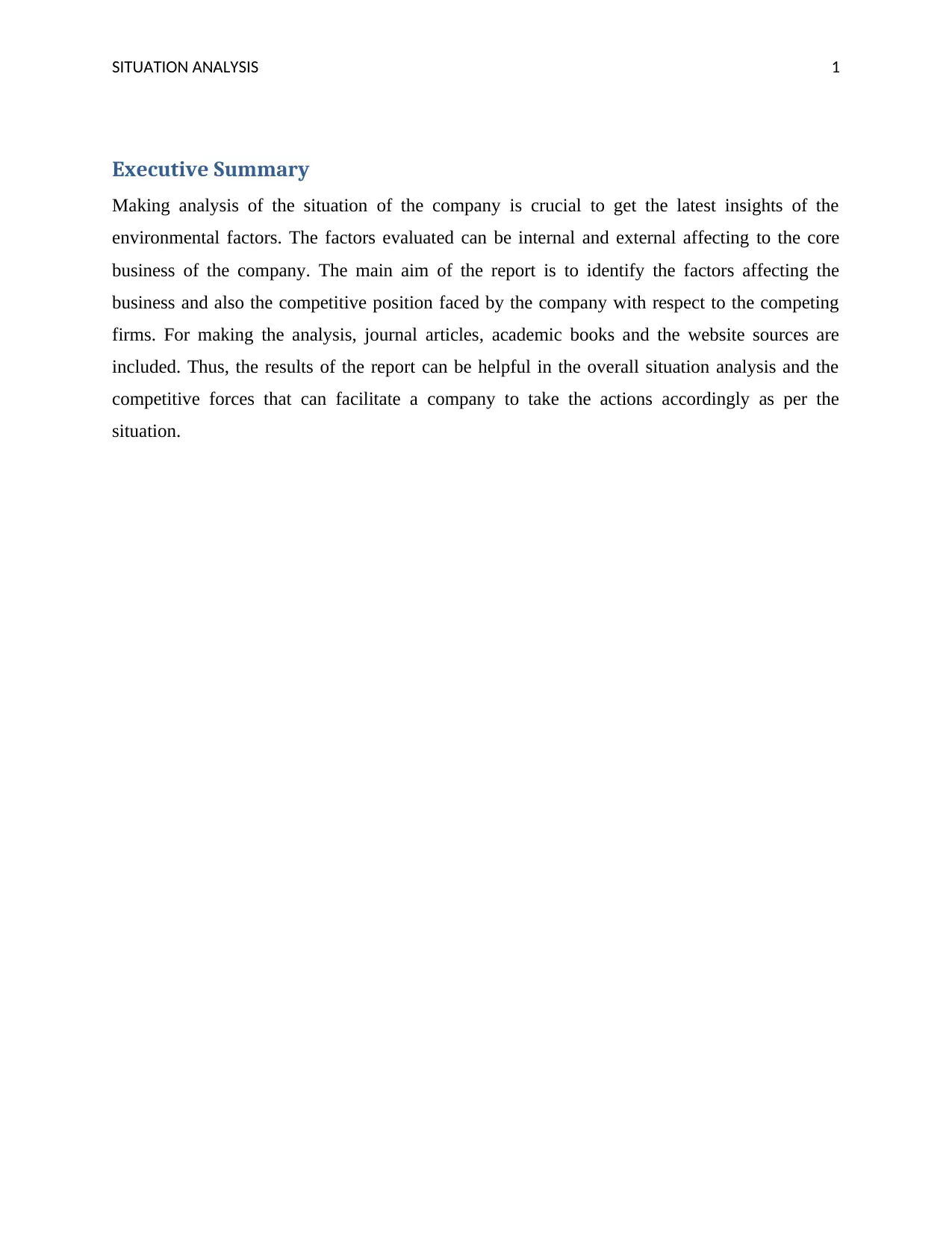
SITUATION ANALYSIS 1
Executive Summary
Making analysis of the situation of the company is crucial to get the latest insights of the
environmental factors. The factors evaluated can be internal and external affecting to the core
business of the company. The main aim of the report is to identify the factors affecting the
business and also the competitive position faced by the company with respect to the competing
firms. For making the analysis, journal articles, academic books and the website sources are
included. Thus, the results of the report can be helpful in the overall situation analysis and the
competitive forces that can facilitate a company to take the actions accordingly as per the
situation.
Executive Summary
Making analysis of the situation of the company is crucial to get the latest insights of the
environmental factors. The factors evaluated can be internal and external affecting to the core
business of the company. The main aim of the report is to identify the factors affecting the
business and also the competitive position faced by the company with respect to the competing
firms. For making the analysis, journal articles, academic books and the website sources are
included. Thus, the results of the report can be helpful in the overall situation analysis and the
competitive forces that can facilitate a company to take the actions accordingly as per the
situation.
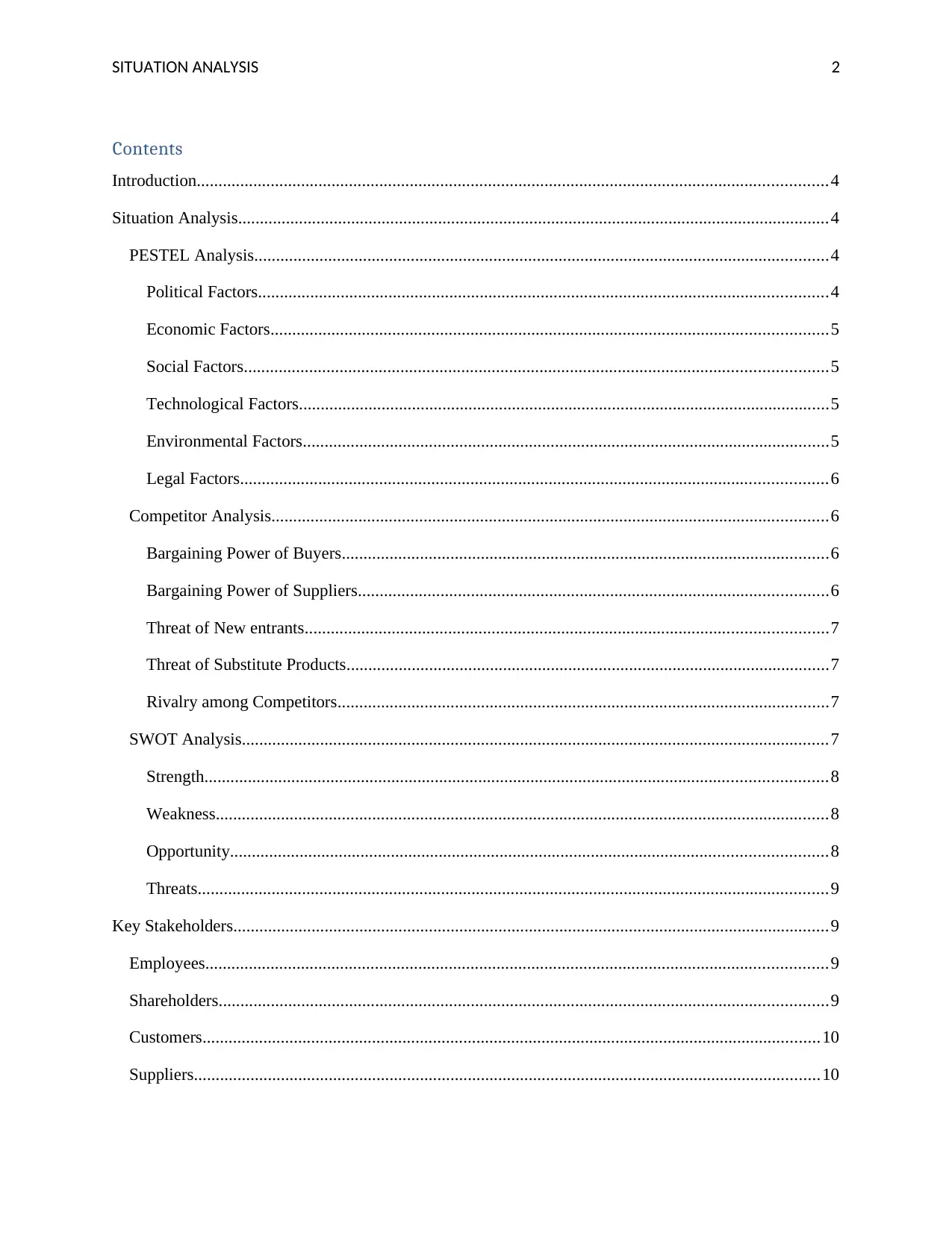
SITUATION ANALYSIS 2
Contents
Introduction.................................................................................................................................................4
Situation Analysis........................................................................................................................................4
PESTEL Analysis....................................................................................................................................4
Political Factors...................................................................................................................................4
Economic Factors................................................................................................................................5
Social Factors......................................................................................................................................5
Technological Factors..........................................................................................................................5
Environmental Factors.........................................................................................................................5
Legal Factors.......................................................................................................................................6
Competitor Analysis................................................................................................................................6
Bargaining Power of Buyers................................................................................................................6
Bargaining Power of Suppliers............................................................................................................6
Threat of New entrants........................................................................................................................7
Threat of Substitute Products...............................................................................................................7
Rivalry among Competitors.................................................................................................................7
SWOT Analysis.......................................................................................................................................7
Strength...............................................................................................................................................8
Weakness.............................................................................................................................................8
Opportunity.........................................................................................................................................8
Threats.................................................................................................................................................9
Key Stakeholders.........................................................................................................................................9
Employees...............................................................................................................................................9
Shareholders............................................................................................................................................9
Customers..............................................................................................................................................10
Suppliers................................................................................................................................................10
Contents
Introduction.................................................................................................................................................4
Situation Analysis........................................................................................................................................4
PESTEL Analysis....................................................................................................................................4
Political Factors...................................................................................................................................4
Economic Factors................................................................................................................................5
Social Factors......................................................................................................................................5
Technological Factors..........................................................................................................................5
Environmental Factors.........................................................................................................................5
Legal Factors.......................................................................................................................................6
Competitor Analysis................................................................................................................................6
Bargaining Power of Buyers................................................................................................................6
Bargaining Power of Suppliers............................................................................................................6
Threat of New entrants........................................................................................................................7
Threat of Substitute Products...............................................................................................................7
Rivalry among Competitors.................................................................................................................7
SWOT Analysis.......................................................................................................................................7
Strength...............................................................................................................................................8
Weakness.............................................................................................................................................8
Opportunity.........................................................................................................................................8
Threats.................................................................................................................................................9
Key Stakeholders.........................................................................................................................................9
Employees...............................................................................................................................................9
Shareholders............................................................................................................................................9
Customers..............................................................................................................................................10
Suppliers................................................................................................................................................10
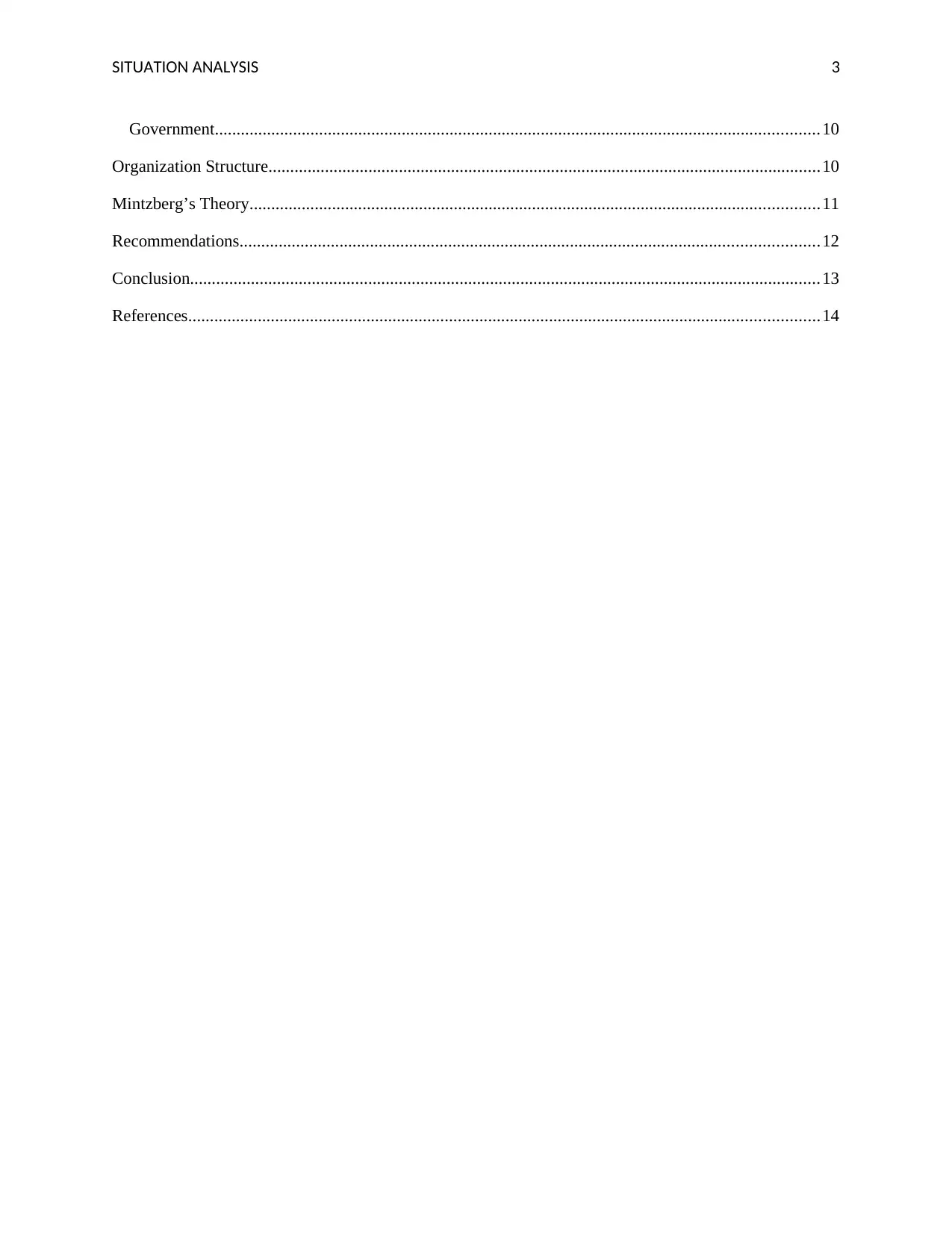
SITUATION ANALYSIS 3
Government...........................................................................................................................................10
Organization Structure...............................................................................................................................10
Mintzberg’s Theory...................................................................................................................................11
Recommendations.....................................................................................................................................12
Conclusion.................................................................................................................................................13
References.................................................................................................................................................14
Government...........................................................................................................................................10
Organization Structure...............................................................................................................................10
Mintzberg’s Theory...................................................................................................................................11
Recommendations.....................................................................................................................................12
Conclusion.................................................................................................................................................13
References.................................................................................................................................................14
Secure Best Marks with AI Grader
Need help grading? Try our AI Grader for instant feedback on your assignments.
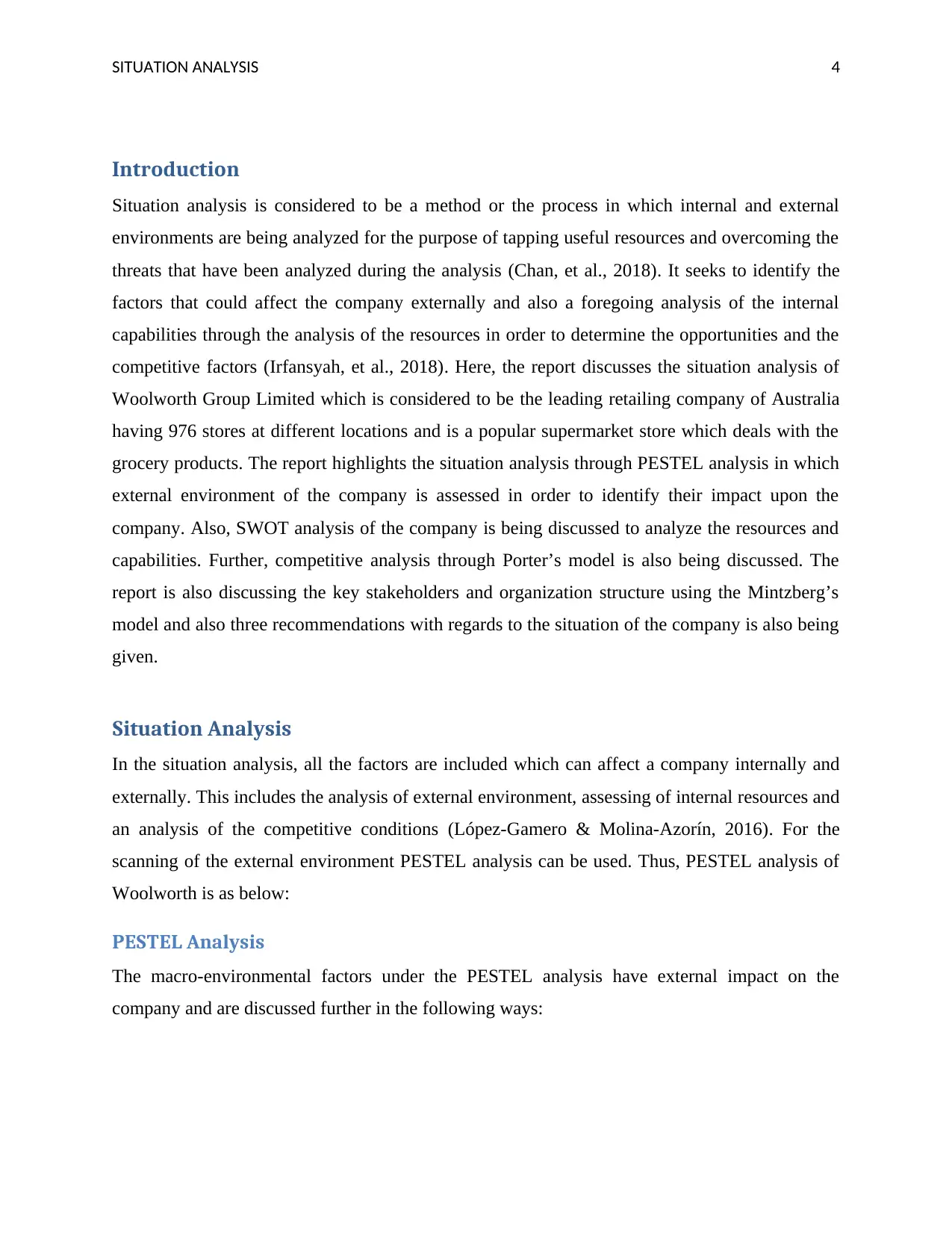
SITUATION ANALYSIS 4
Introduction
Situation analysis is considered to be a method or the process in which internal and external
environments are being analyzed for the purpose of tapping useful resources and overcoming the
threats that have been analyzed during the analysis (Chan, et al., 2018). It seeks to identify the
factors that could affect the company externally and also a foregoing analysis of the internal
capabilities through the analysis of the resources in order to determine the opportunities and the
competitive factors (Irfansyah, et al., 2018). Here, the report discusses the situation analysis of
Woolworth Group Limited which is considered to be the leading retailing company of Australia
having 976 stores at different locations and is a popular supermarket store which deals with the
grocery products. The report highlights the situation analysis through PESTEL analysis in which
external environment of the company is assessed in order to identify their impact upon the
company. Also, SWOT analysis of the company is being discussed to analyze the resources and
capabilities. Further, competitive analysis through Porter’s model is also being discussed. The
report is also discussing the key stakeholders and organization structure using the Mintzberg’s
model and also three recommendations with regards to the situation of the company is also being
given.
Situation Analysis
In the situation analysis, all the factors are included which can affect a company internally and
externally. This includes the analysis of external environment, assessing of internal resources and
an analysis of the competitive conditions (López-Gamero & Molina-Azorín, 2016). For the
scanning of the external environment PESTEL analysis can be used. Thus, PESTEL analysis of
Woolworth is as below:
PESTEL Analysis
The macro-environmental factors under the PESTEL analysis have external impact on the
company and are discussed further in the following ways:
Introduction
Situation analysis is considered to be a method or the process in which internal and external
environments are being analyzed for the purpose of tapping useful resources and overcoming the
threats that have been analyzed during the analysis (Chan, et al., 2018). It seeks to identify the
factors that could affect the company externally and also a foregoing analysis of the internal
capabilities through the analysis of the resources in order to determine the opportunities and the
competitive factors (Irfansyah, et al., 2018). Here, the report discusses the situation analysis of
Woolworth Group Limited which is considered to be the leading retailing company of Australia
having 976 stores at different locations and is a popular supermarket store which deals with the
grocery products. The report highlights the situation analysis through PESTEL analysis in which
external environment of the company is assessed in order to identify their impact upon the
company. Also, SWOT analysis of the company is being discussed to analyze the resources and
capabilities. Further, competitive analysis through Porter’s model is also being discussed. The
report is also discussing the key stakeholders and organization structure using the Mintzberg’s
model and also three recommendations with regards to the situation of the company is also being
given.
Situation Analysis
In the situation analysis, all the factors are included which can affect a company internally and
externally. This includes the analysis of external environment, assessing of internal resources and
an analysis of the competitive conditions (López-Gamero & Molina-Azorín, 2016). For the
scanning of the external environment PESTEL analysis can be used. Thus, PESTEL analysis of
Woolworth is as below:
PESTEL Analysis
The macro-environmental factors under the PESTEL analysis have external impact on the
company and are discussed further in the following ways:
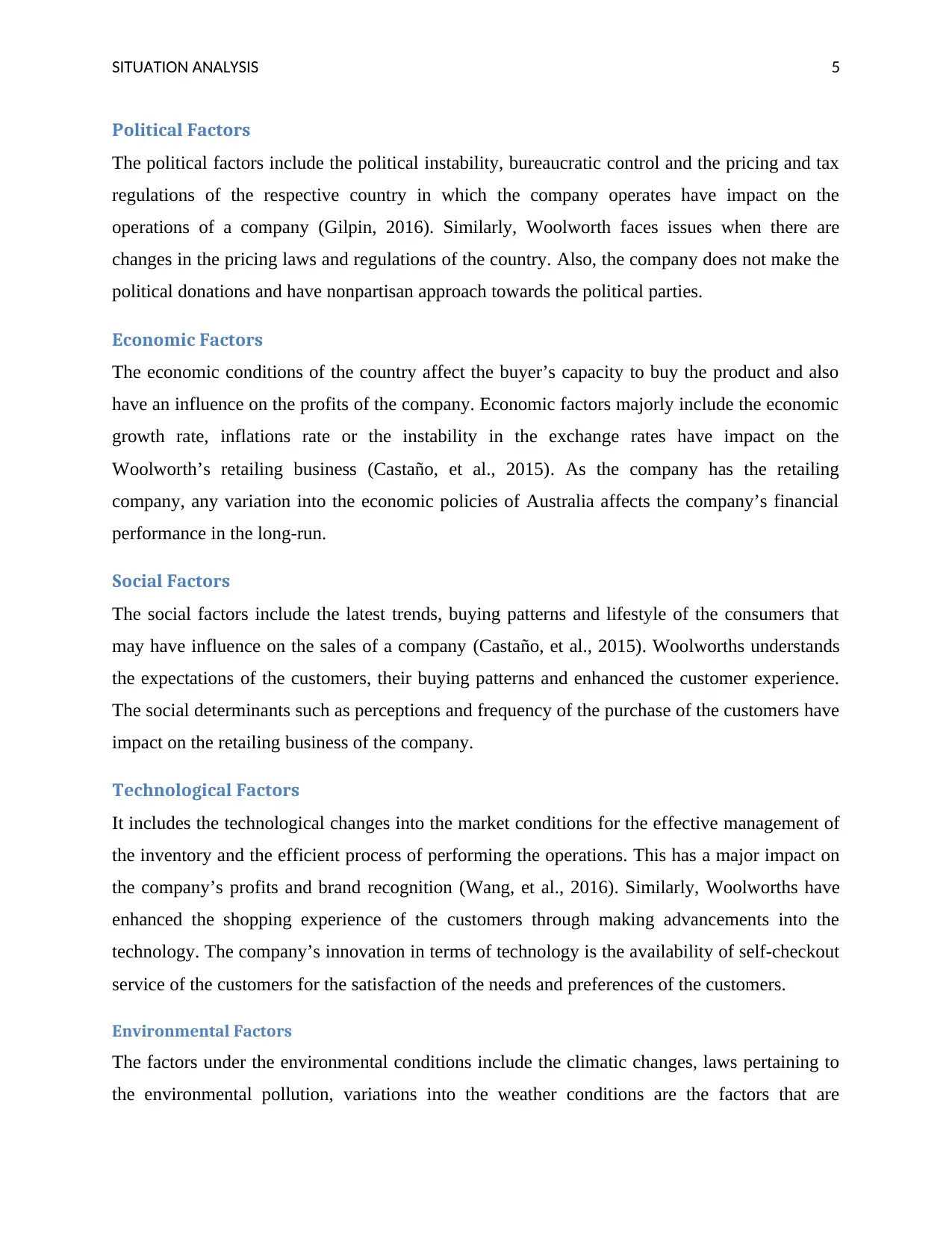
SITUATION ANALYSIS 5
Political Factors
The political factors include the political instability, bureaucratic control and the pricing and tax
regulations of the respective country in which the company operates have impact on the
operations of a company (Gilpin, 2016). Similarly, Woolworth faces issues when there are
changes in the pricing laws and regulations of the country. Also, the company does not make the
political donations and have nonpartisan approach towards the political parties.
Economic Factors
The economic conditions of the country affect the buyer’s capacity to buy the product and also
have an influence on the profits of the company. Economic factors majorly include the economic
growth rate, inflations rate or the instability in the exchange rates have impact on the
Woolworth’s retailing business (Castaño, et al., 2015). As the company has the retailing
company, any variation into the economic policies of Australia affects the company’s financial
performance in the long-run.
Social Factors
The social factors include the latest trends, buying patterns and lifestyle of the consumers that
may have influence on the sales of a company (Castaño, et al., 2015). Woolworths understands
the expectations of the customers, their buying patterns and enhanced the customer experience.
The social determinants such as perceptions and frequency of the purchase of the customers have
impact on the retailing business of the company.
Technological Factors
It includes the technological changes into the market conditions for the effective management of
the inventory and the efficient process of performing the operations. This has a major impact on
the company’s profits and brand recognition (Wang, et al., 2016). Similarly, Woolworths have
enhanced the shopping experience of the customers through making advancements into the
technology. The company’s innovation in terms of technology is the availability of self-checkout
service of the customers for the satisfaction of the needs and preferences of the customers.
Environmental Factors
The factors under the environmental conditions include the climatic changes, laws pertaining to
the environmental pollution, variations into the weather conditions are the factors that are
Political Factors
The political factors include the political instability, bureaucratic control and the pricing and tax
regulations of the respective country in which the company operates have impact on the
operations of a company (Gilpin, 2016). Similarly, Woolworth faces issues when there are
changes in the pricing laws and regulations of the country. Also, the company does not make the
political donations and have nonpartisan approach towards the political parties.
Economic Factors
The economic conditions of the country affect the buyer’s capacity to buy the product and also
have an influence on the profits of the company. Economic factors majorly include the economic
growth rate, inflations rate or the instability in the exchange rates have impact on the
Woolworth’s retailing business (Castaño, et al., 2015). As the company has the retailing
company, any variation into the economic policies of Australia affects the company’s financial
performance in the long-run.
Social Factors
The social factors include the latest trends, buying patterns and lifestyle of the consumers that
may have influence on the sales of a company (Castaño, et al., 2015). Woolworths understands
the expectations of the customers, their buying patterns and enhanced the customer experience.
The social determinants such as perceptions and frequency of the purchase of the customers have
impact on the retailing business of the company.
Technological Factors
It includes the technological changes into the market conditions for the effective management of
the inventory and the efficient process of performing the operations. This has a major impact on
the company’s profits and brand recognition (Wang, et al., 2016). Similarly, Woolworths have
enhanced the shopping experience of the customers through making advancements into the
technology. The company’s innovation in terms of technology is the availability of self-checkout
service of the customers for the satisfaction of the needs and preferences of the customers.
Environmental Factors
The factors under the environmental conditions include the climatic changes, laws pertaining to
the environmental pollution, variations into the weather conditions are the factors that are
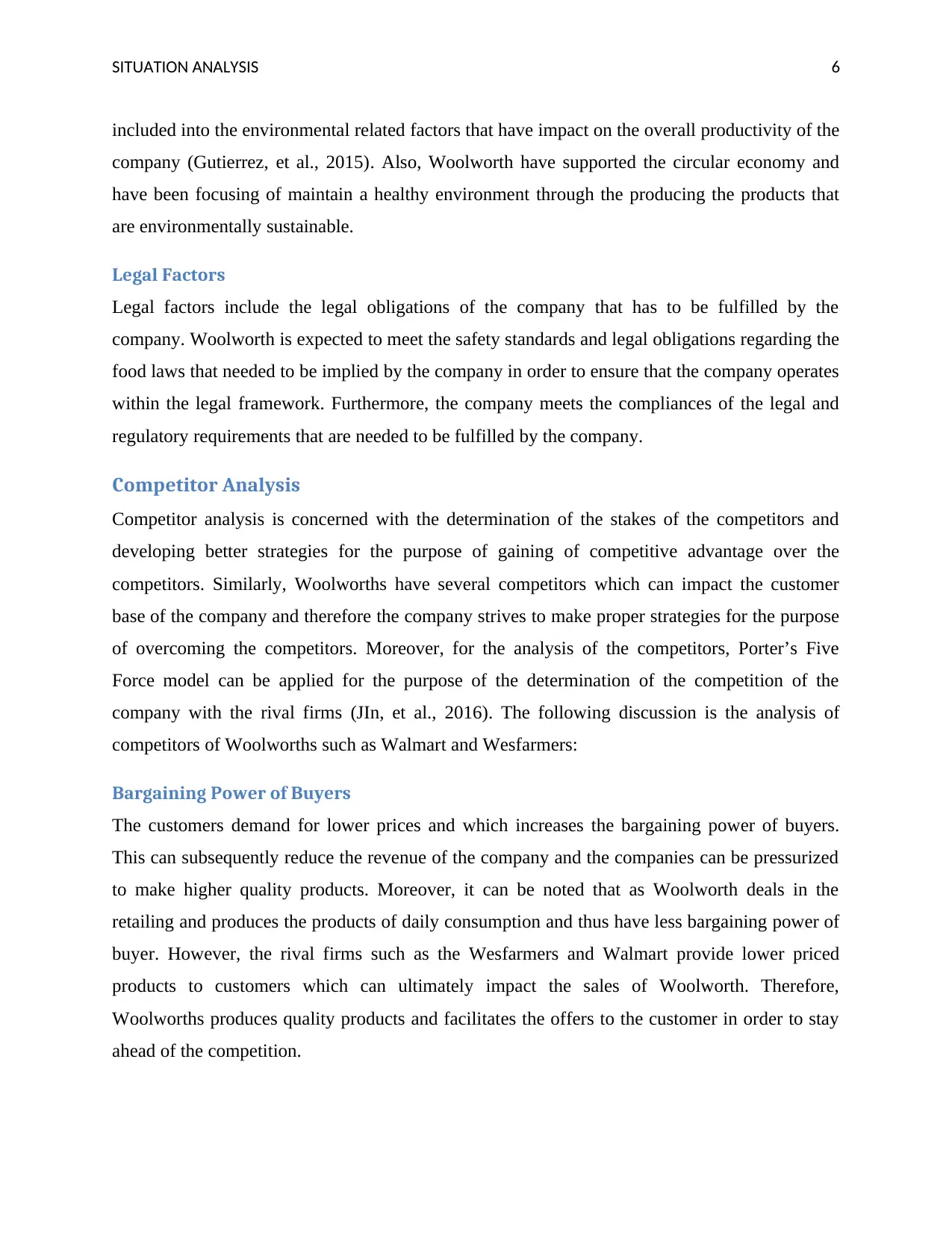
SITUATION ANALYSIS 6
included into the environmental related factors that have impact on the overall productivity of the
company (Gutierrez, et al., 2015). Also, Woolworth have supported the circular economy and
have been focusing of maintain a healthy environment through the producing the products that
are environmentally sustainable.
Legal Factors
Legal factors include the legal obligations of the company that has to be fulfilled by the
company. Woolworth is expected to meet the safety standards and legal obligations regarding the
food laws that needed to be implied by the company in order to ensure that the company operates
within the legal framework. Furthermore, the company meets the compliances of the legal and
regulatory requirements that are needed to be fulfilled by the company.
Competitor Analysis
Competitor analysis is concerned with the determination of the stakes of the competitors and
developing better strategies for the purpose of gaining of competitive advantage over the
competitors. Similarly, Woolworths have several competitors which can impact the customer
base of the company and therefore the company strives to make proper strategies for the purpose
of overcoming the competitors. Moreover, for the analysis of the competitors, Porter’s Five
Force model can be applied for the purpose of the determination of the competition of the
company with the rival firms (JIn, et al., 2016). The following discussion is the analysis of
competitors of Woolworths such as Walmart and Wesfarmers:
Bargaining Power of Buyers
The customers demand for lower prices and which increases the bargaining power of buyers.
This can subsequently reduce the revenue of the company and the companies can be pressurized
to make higher quality products. Moreover, it can be noted that as Woolworth deals in the
retailing and produces the products of daily consumption and thus have less bargaining power of
buyer. However, the rival firms such as the Wesfarmers and Walmart provide lower priced
products to customers which can ultimately impact the sales of Woolworth. Therefore,
Woolworths produces quality products and facilitates the offers to the customer in order to stay
ahead of the competition.
included into the environmental related factors that have impact on the overall productivity of the
company (Gutierrez, et al., 2015). Also, Woolworth have supported the circular economy and
have been focusing of maintain a healthy environment through the producing the products that
are environmentally sustainable.
Legal Factors
Legal factors include the legal obligations of the company that has to be fulfilled by the
company. Woolworth is expected to meet the safety standards and legal obligations regarding the
food laws that needed to be implied by the company in order to ensure that the company operates
within the legal framework. Furthermore, the company meets the compliances of the legal and
regulatory requirements that are needed to be fulfilled by the company.
Competitor Analysis
Competitor analysis is concerned with the determination of the stakes of the competitors and
developing better strategies for the purpose of gaining of competitive advantage over the
competitors. Similarly, Woolworths have several competitors which can impact the customer
base of the company and therefore the company strives to make proper strategies for the purpose
of overcoming the competitors. Moreover, for the analysis of the competitors, Porter’s Five
Force model can be applied for the purpose of the determination of the competition of the
company with the rival firms (JIn, et al., 2016). The following discussion is the analysis of
competitors of Woolworths such as Walmart and Wesfarmers:
Bargaining Power of Buyers
The customers demand for lower prices and which increases the bargaining power of buyers.
This can subsequently reduce the revenue of the company and the companies can be pressurized
to make higher quality products. Moreover, it can be noted that as Woolworth deals in the
retailing and produces the products of daily consumption and thus have less bargaining power of
buyer. However, the rival firms such as the Wesfarmers and Walmart provide lower priced
products to customers which can ultimately impact the sales of Woolworth. Therefore,
Woolworths produces quality products and facilitates the offers to the customer in order to stay
ahead of the competition.
Paraphrase This Document
Need a fresh take? Get an instant paraphrase of this document with our AI Paraphraser
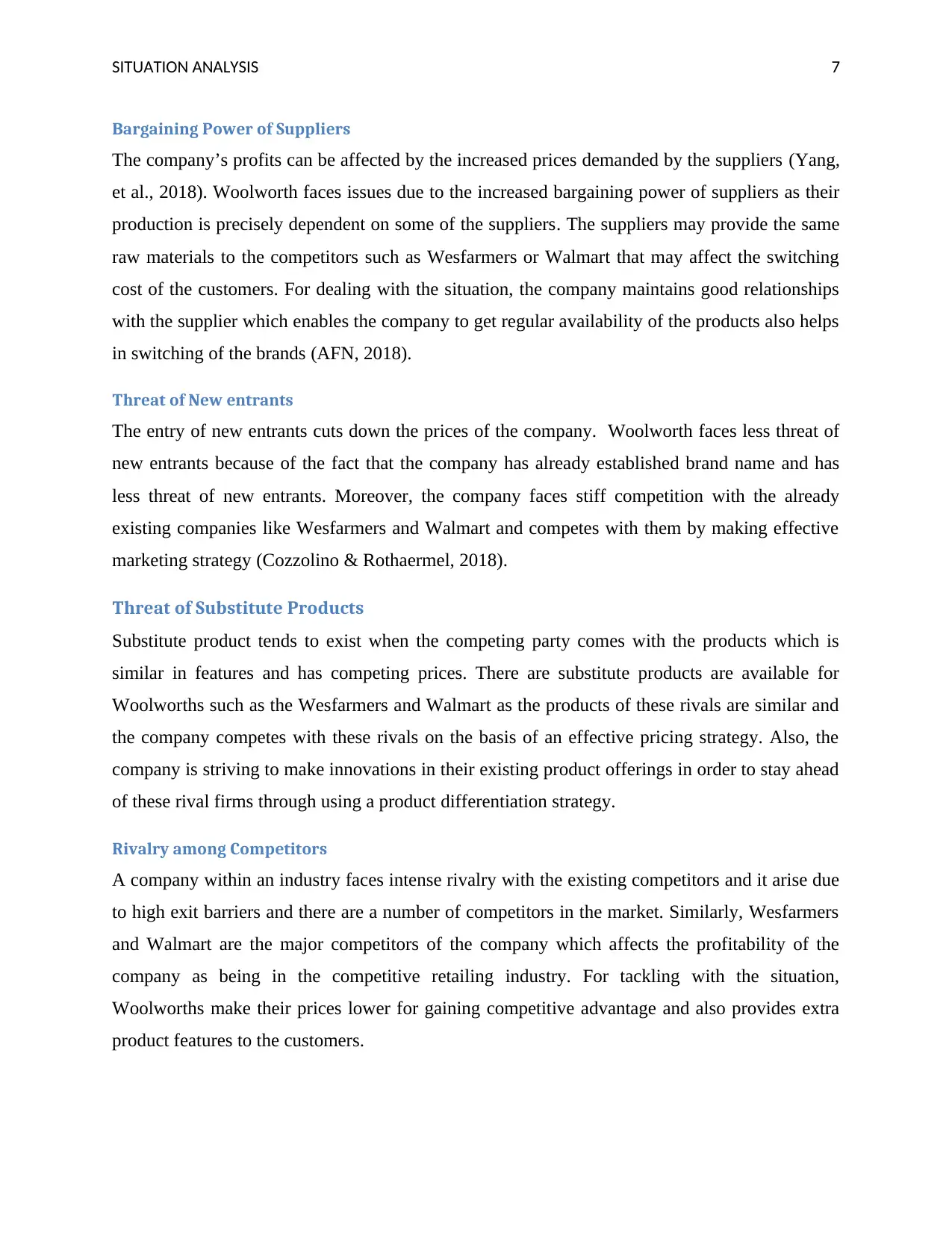
SITUATION ANALYSIS 7
Bargaining Power of Suppliers
The company’s profits can be affected by the increased prices demanded by the suppliers (Yang,
et al., 2018). Woolworth faces issues due to the increased bargaining power of suppliers as their
production is precisely dependent on some of the suppliers. The suppliers may provide the same
raw materials to the competitors such as Wesfarmers or Walmart that may affect the switching
cost of the customers. For dealing with the situation, the company maintains good relationships
with the supplier which enables the company to get regular availability of the products also helps
in switching of the brands (AFN, 2018).
Threat of New entrants
The entry of new entrants cuts down the prices of the company. Woolworth faces less threat of
new entrants because of the fact that the company has already established brand name and has
less threat of new entrants. Moreover, the company faces stiff competition with the already
existing companies like Wesfarmers and Walmart and competes with them by making effective
marketing strategy (Cozzolino & Rothaermel, 2018).
Threat of Substitute Products
Substitute product tends to exist when the competing party comes with the products which is
similar in features and has competing prices. There are substitute products are available for
Woolworths such as the Wesfarmers and Walmart as the products of these rivals are similar and
the company competes with these rivals on the basis of an effective pricing strategy. Also, the
company is striving to make innovations in their existing product offerings in order to stay ahead
of these rival firms through using a product differentiation strategy.
Rivalry among Competitors
A company within an industry faces intense rivalry with the existing competitors and it arise due
to high exit barriers and there are a number of competitors in the market. Similarly, Wesfarmers
and Walmart are the major competitors of the company which affects the profitability of the
company as being in the competitive retailing industry. For tackling with the situation,
Woolworths make their prices lower for gaining competitive advantage and also provides extra
product features to the customers.
Bargaining Power of Suppliers
The company’s profits can be affected by the increased prices demanded by the suppliers (Yang,
et al., 2018). Woolworth faces issues due to the increased bargaining power of suppliers as their
production is precisely dependent on some of the suppliers. The suppliers may provide the same
raw materials to the competitors such as Wesfarmers or Walmart that may affect the switching
cost of the customers. For dealing with the situation, the company maintains good relationships
with the supplier which enables the company to get regular availability of the products also helps
in switching of the brands (AFN, 2018).
Threat of New entrants
The entry of new entrants cuts down the prices of the company. Woolworth faces less threat of
new entrants because of the fact that the company has already established brand name and has
less threat of new entrants. Moreover, the company faces stiff competition with the already
existing companies like Wesfarmers and Walmart and competes with them by making effective
marketing strategy (Cozzolino & Rothaermel, 2018).
Threat of Substitute Products
Substitute product tends to exist when the competing party comes with the products which is
similar in features and has competing prices. There are substitute products are available for
Woolworths such as the Wesfarmers and Walmart as the products of these rivals are similar and
the company competes with these rivals on the basis of an effective pricing strategy. Also, the
company is striving to make innovations in their existing product offerings in order to stay ahead
of these rival firms through using a product differentiation strategy.
Rivalry among Competitors
A company within an industry faces intense rivalry with the existing competitors and it arise due
to high exit barriers and there are a number of competitors in the market. Similarly, Wesfarmers
and Walmart are the major competitors of the company which affects the profitability of the
company as being in the competitive retailing industry. For tackling with the situation,
Woolworths make their prices lower for gaining competitive advantage and also provides extra
product features to the customers.
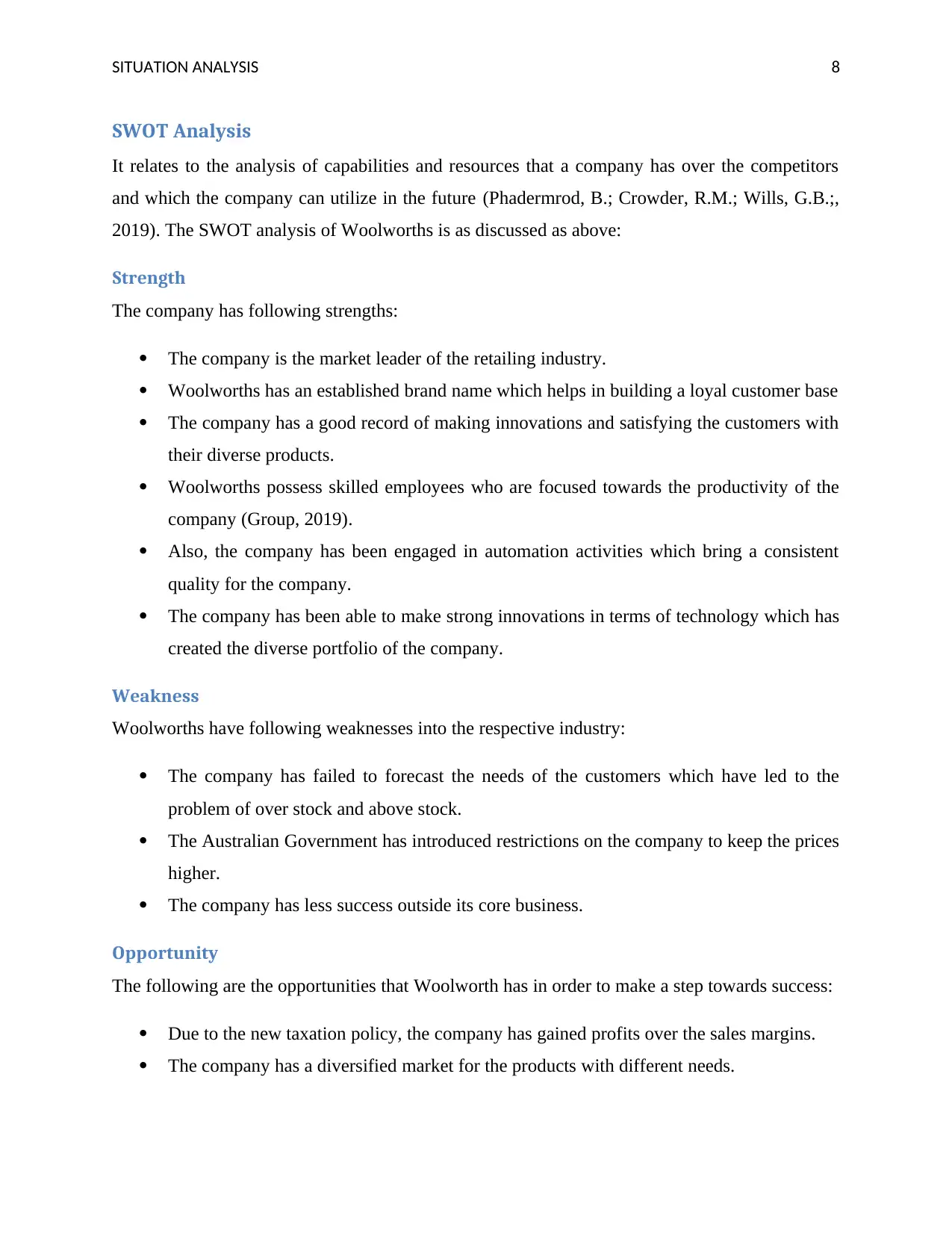
SITUATION ANALYSIS 8
SWOT Analysis
It relates to the analysis of capabilities and resources that a company has over the competitors
and which the company can utilize in the future (Phadermrod, B.; Crowder, R.M.; Wills, G.B.;,
2019). The SWOT analysis of Woolworths is as discussed as above:
Strength
The company has following strengths:
The company is the market leader of the retailing industry.
Woolworths has an established brand name which helps in building a loyal customer base
The company has a good record of making innovations and satisfying the customers with
their diverse products.
Woolworths possess skilled employees who are focused towards the productivity of the
company (Group, 2019).
Also, the company has been engaged in automation activities which bring a consistent
quality for the company.
The company has been able to make strong innovations in terms of technology which has
created the diverse portfolio of the company.
Weakness
Woolworths have following weaknesses into the respective industry:
The company has failed to forecast the needs of the customers which have led to the
problem of over stock and above stock.
The Australian Government has introduced restrictions on the company to keep the prices
higher.
The company has less success outside its core business.
Opportunity
The following are the opportunities that Woolworth has in order to make a step towards success:
Due to the new taxation policy, the company has gained profits over the sales margins.
The company has a diversified market for the products with different needs.
SWOT Analysis
It relates to the analysis of capabilities and resources that a company has over the competitors
and which the company can utilize in the future (Phadermrod, B.; Crowder, R.M.; Wills, G.B.;,
2019). The SWOT analysis of Woolworths is as discussed as above:
Strength
The company has following strengths:
The company is the market leader of the retailing industry.
Woolworths has an established brand name which helps in building a loyal customer base
The company has a good record of making innovations and satisfying the customers with
their diverse products.
Woolworths possess skilled employees who are focused towards the productivity of the
company (Group, 2019).
Also, the company has been engaged in automation activities which bring a consistent
quality for the company.
The company has been able to make strong innovations in terms of technology which has
created the diverse portfolio of the company.
Weakness
Woolworths have following weaknesses into the respective industry:
The company has failed to forecast the needs of the customers which have led to the
problem of over stock and above stock.
The Australian Government has introduced restrictions on the company to keep the prices
higher.
The company has less success outside its core business.
Opportunity
The following are the opportunities that Woolworth has in order to make a step towards success:
Due to the new taxation policy, the company has gained profits over the sales margins.
The company has a diversified market for the products with different needs.
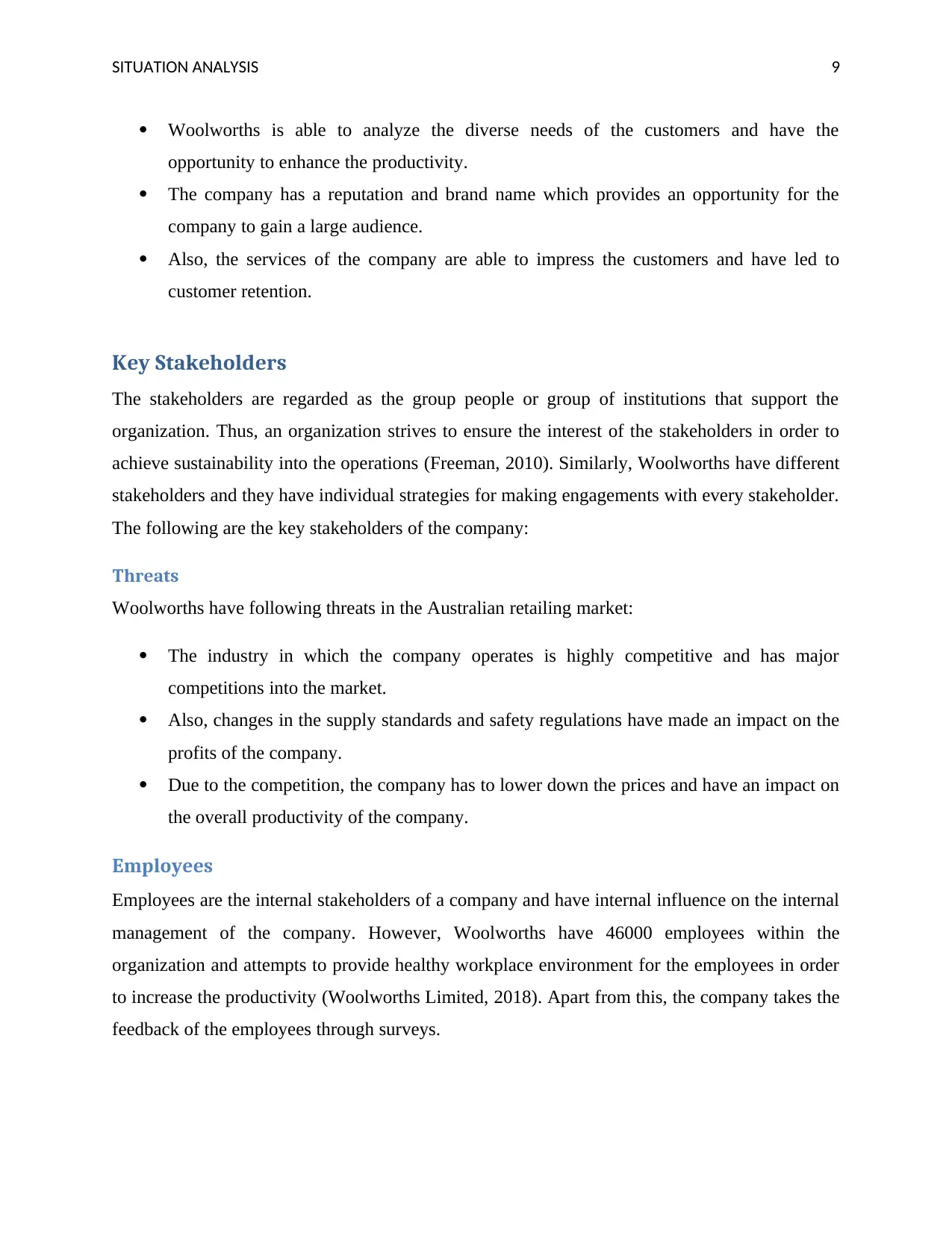
SITUATION ANALYSIS 9
Woolworths is able to analyze the diverse needs of the customers and have the
opportunity to enhance the productivity.
The company has a reputation and brand name which provides an opportunity for the
company to gain a large audience.
Also, the services of the company are able to impress the customers and have led to
customer retention.
Key Stakeholders
The stakeholders are regarded as the group people or group of institutions that support the
organization. Thus, an organization strives to ensure the interest of the stakeholders in order to
achieve sustainability into the operations (Freeman, 2010). Similarly, Woolworths have different
stakeholders and they have individual strategies for making engagements with every stakeholder.
The following are the key stakeholders of the company:
Threats
Woolworths have following threats in the Australian retailing market:
The industry in which the company operates is highly competitive and has major
competitions into the market.
Also, changes in the supply standards and safety regulations have made an impact on the
profits of the company.
Due to the competition, the company has to lower down the prices and have an impact on
the overall productivity of the company.
Employees
Employees are the internal stakeholders of a company and have internal influence on the internal
management of the company. However, Woolworths have 46000 employees within the
organization and attempts to provide healthy workplace environment for the employees in order
to increase the productivity (Woolworths Limited, 2018). Apart from this, the company takes the
feedback of the employees through surveys.
Woolworths is able to analyze the diverse needs of the customers and have the
opportunity to enhance the productivity.
The company has a reputation and brand name which provides an opportunity for the
company to gain a large audience.
Also, the services of the company are able to impress the customers and have led to
customer retention.
Key Stakeholders
The stakeholders are regarded as the group people or group of institutions that support the
organization. Thus, an organization strives to ensure the interest of the stakeholders in order to
achieve sustainability into the operations (Freeman, 2010). Similarly, Woolworths have different
stakeholders and they have individual strategies for making engagements with every stakeholder.
The following are the key stakeholders of the company:
Threats
Woolworths have following threats in the Australian retailing market:
The industry in which the company operates is highly competitive and has major
competitions into the market.
Also, changes in the supply standards and safety regulations have made an impact on the
profits of the company.
Due to the competition, the company has to lower down the prices and have an impact on
the overall productivity of the company.
Employees
Employees are the internal stakeholders of a company and have internal influence on the internal
management of the company. However, Woolworths have 46000 employees within the
organization and attempts to provide healthy workplace environment for the employees in order
to increase the productivity (Woolworths Limited, 2018). Apart from this, the company takes the
feedback of the employees through surveys.
Secure Best Marks with AI Grader
Need help grading? Try our AI Grader for instant feedback on your assignments.
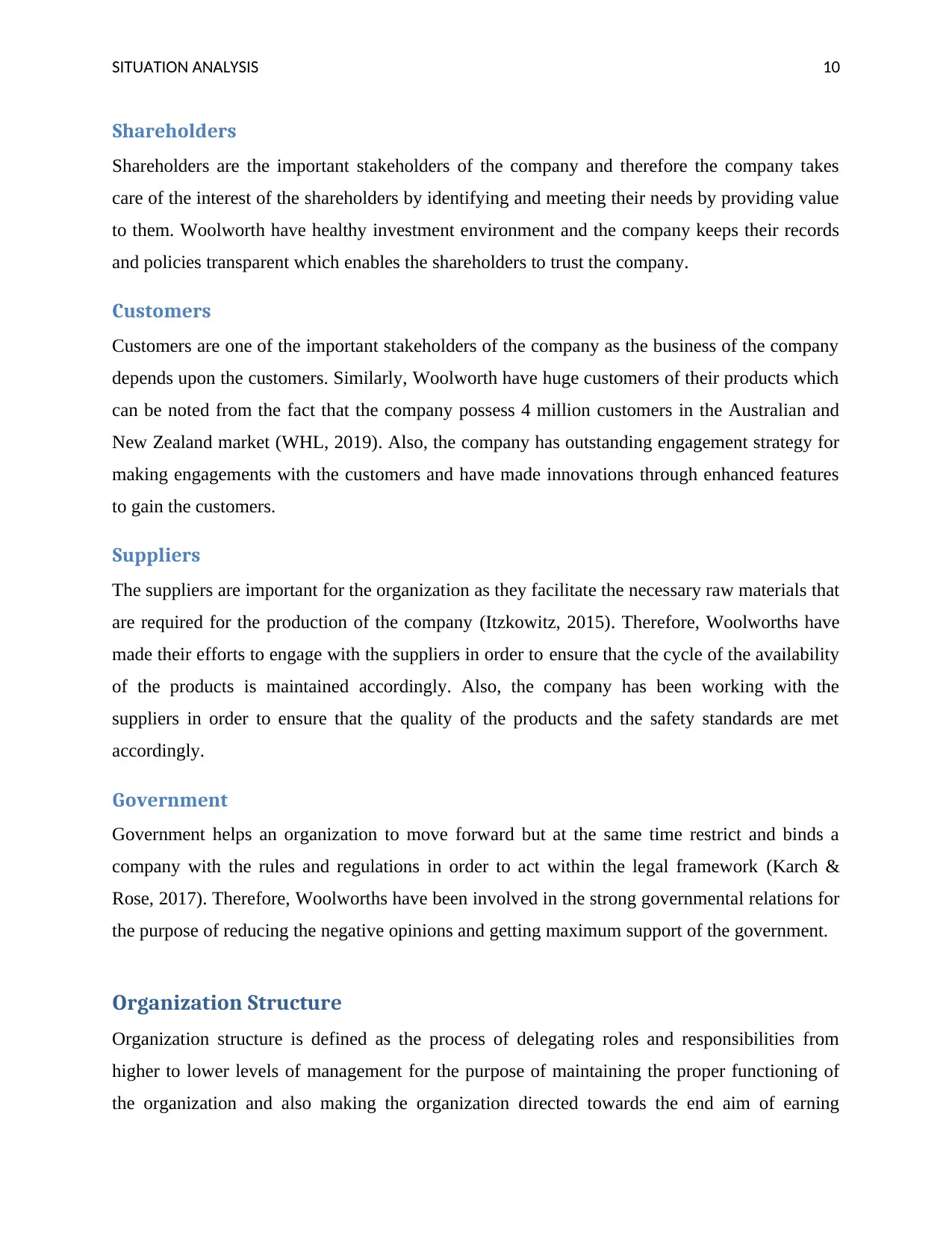
SITUATION ANALYSIS 10
Shareholders
Shareholders are the important stakeholders of the company and therefore the company takes
care of the interest of the shareholders by identifying and meeting their needs by providing value
to them. Woolworth have healthy investment environment and the company keeps their records
and policies transparent which enables the shareholders to trust the company.
Customers
Customers are one of the important stakeholders of the company as the business of the company
depends upon the customers. Similarly, Woolworth have huge customers of their products which
can be noted from the fact that the company possess 4 million customers in the Australian and
New Zealand market (WHL, 2019). Also, the company has outstanding engagement strategy for
making engagements with the customers and have made innovations through enhanced features
to gain the customers.
Suppliers
The suppliers are important for the organization as they facilitate the necessary raw materials that
are required for the production of the company (Itzkowitz, 2015). Therefore, Woolworths have
made their efforts to engage with the suppliers in order to ensure that the cycle of the availability
of the products is maintained accordingly. Also, the company has been working with the
suppliers in order to ensure that the quality of the products and the safety standards are met
accordingly.
Government
Government helps an organization to move forward but at the same time restrict and binds a
company with the rules and regulations in order to act within the legal framework (Karch &
Rose, 2017). Therefore, Woolworths have been involved in the strong governmental relations for
the purpose of reducing the negative opinions and getting maximum support of the government.
Organization Structure
Organization structure is defined as the process of delegating roles and responsibilities from
higher to lower levels of management for the purpose of maintaining the proper functioning of
the organization and also making the organization directed towards the end aim of earning
Shareholders
Shareholders are the important stakeholders of the company and therefore the company takes
care of the interest of the shareholders by identifying and meeting their needs by providing value
to them. Woolworth have healthy investment environment and the company keeps their records
and policies transparent which enables the shareholders to trust the company.
Customers
Customers are one of the important stakeholders of the company as the business of the company
depends upon the customers. Similarly, Woolworth have huge customers of their products which
can be noted from the fact that the company possess 4 million customers in the Australian and
New Zealand market (WHL, 2019). Also, the company has outstanding engagement strategy for
making engagements with the customers and have made innovations through enhanced features
to gain the customers.
Suppliers
The suppliers are important for the organization as they facilitate the necessary raw materials that
are required for the production of the company (Itzkowitz, 2015). Therefore, Woolworths have
made their efforts to engage with the suppliers in order to ensure that the cycle of the availability
of the products is maintained accordingly. Also, the company has been working with the
suppliers in order to ensure that the quality of the products and the safety standards are met
accordingly.
Government
Government helps an organization to move forward but at the same time restrict and binds a
company with the rules and regulations in order to act within the legal framework (Karch &
Rose, 2017). Therefore, Woolworths have been involved in the strong governmental relations for
the purpose of reducing the negative opinions and getting maximum support of the government.
Organization Structure
Organization structure is defined as the process of delegating roles and responsibilities from
higher to lower levels of management for the purpose of maintaining the proper functioning of
the organization and also making the organization directed towards the end aim of earning
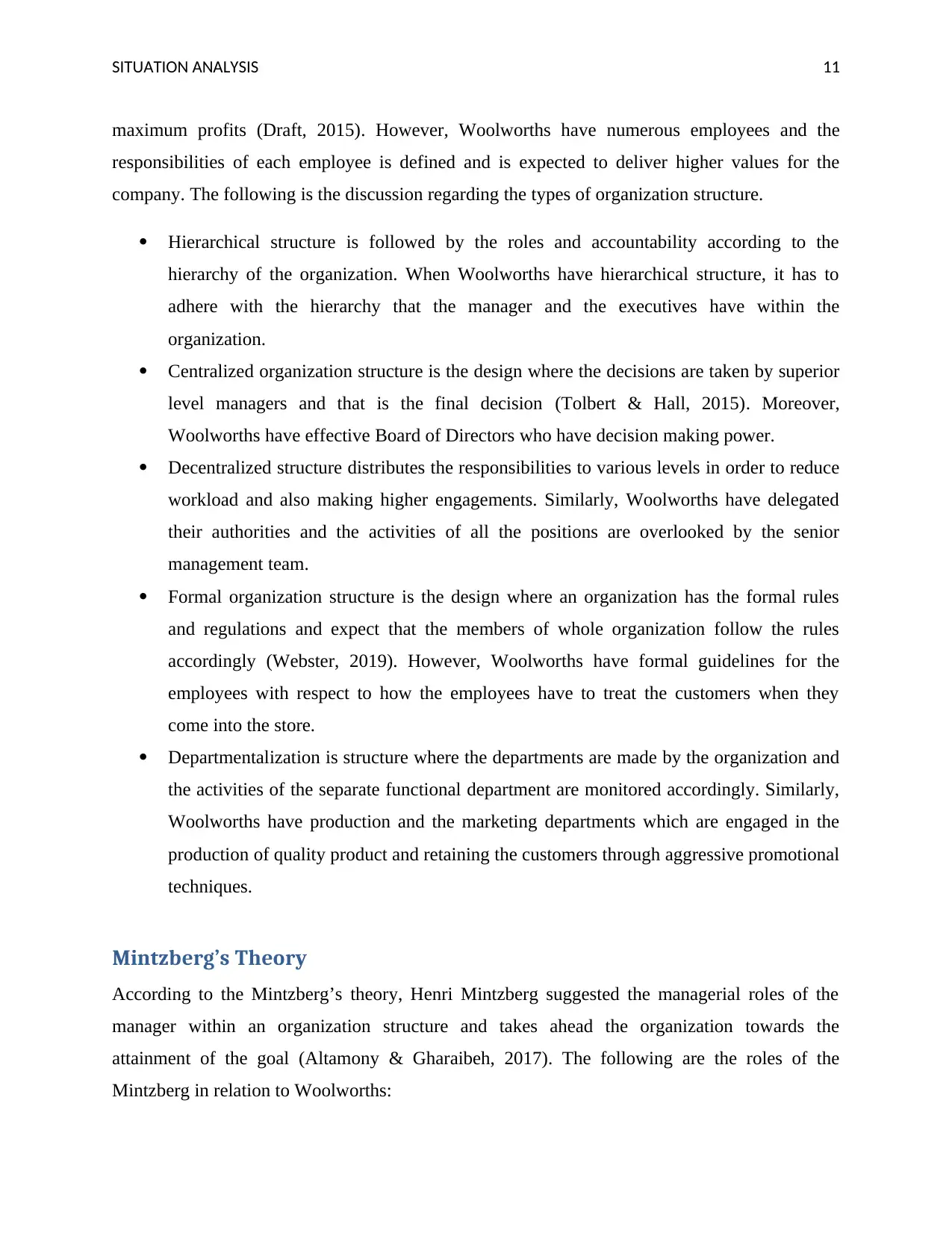
SITUATION ANALYSIS 11
maximum profits (Draft, 2015). However, Woolworths have numerous employees and the
responsibilities of each employee is defined and is expected to deliver higher values for the
company. The following is the discussion regarding the types of organization structure.
Hierarchical structure is followed by the roles and accountability according to the
hierarchy of the organization. When Woolworths have hierarchical structure, it has to
adhere with the hierarchy that the manager and the executives have within the
organization.
Centralized organization structure is the design where the decisions are taken by superior
level managers and that is the final decision (Tolbert & Hall, 2015). Moreover,
Woolworths have effective Board of Directors who have decision making power.
Decentralized structure distributes the responsibilities to various levels in order to reduce
workload and also making higher engagements. Similarly, Woolworths have delegated
their authorities and the activities of all the positions are overlooked by the senior
management team.
Formal organization structure is the design where an organization has the formal rules
and regulations and expect that the members of whole organization follow the rules
accordingly (Webster, 2019). However, Woolworths have formal guidelines for the
employees with respect to how the employees have to treat the customers when they
come into the store.
Departmentalization is structure where the departments are made by the organization and
the activities of the separate functional department are monitored accordingly. Similarly,
Woolworths have production and the marketing departments which are engaged in the
production of quality product and retaining the customers through aggressive promotional
techniques.
Mintzberg’s Theory
According to the Mintzberg’s theory, Henri Mintzberg suggested the managerial roles of the
manager within an organization structure and takes ahead the organization towards the
attainment of the goal (Altamony & Gharaibeh, 2017). The following are the roles of the
Mintzberg in relation to Woolworths:
maximum profits (Draft, 2015). However, Woolworths have numerous employees and the
responsibilities of each employee is defined and is expected to deliver higher values for the
company. The following is the discussion regarding the types of organization structure.
Hierarchical structure is followed by the roles and accountability according to the
hierarchy of the organization. When Woolworths have hierarchical structure, it has to
adhere with the hierarchy that the manager and the executives have within the
organization.
Centralized organization structure is the design where the decisions are taken by superior
level managers and that is the final decision (Tolbert & Hall, 2015). Moreover,
Woolworths have effective Board of Directors who have decision making power.
Decentralized structure distributes the responsibilities to various levels in order to reduce
workload and also making higher engagements. Similarly, Woolworths have delegated
their authorities and the activities of all the positions are overlooked by the senior
management team.
Formal organization structure is the design where an organization has the formal rules
and regulations and expect that the members of whole organization follow the rules
accordingly (Webster, 2019). However, Woolworths have formal guidelines for the
employees with respect to how the employees have to treat the customers when they
come into the store.
Departmentalization is structure where the departments are made by the organization and
the activities of the separate functional department are monitored accordingly. Similarly,
Woolworths have production and the marketing departments which are engaged in the
production of quality product and retaining the customers through aggressive promotional
techniques.
Mintzberg’s Theory
According to the Mintzberg’s theory, Henri Mintzberg suggested the managerial roles of the
manager within an organization structure and takes ahead the organization towards the
attainment of the goal (Altamony & Gharaibeh, 2017). The following are the roles of the
Mintzberg in relation to Woolworths:
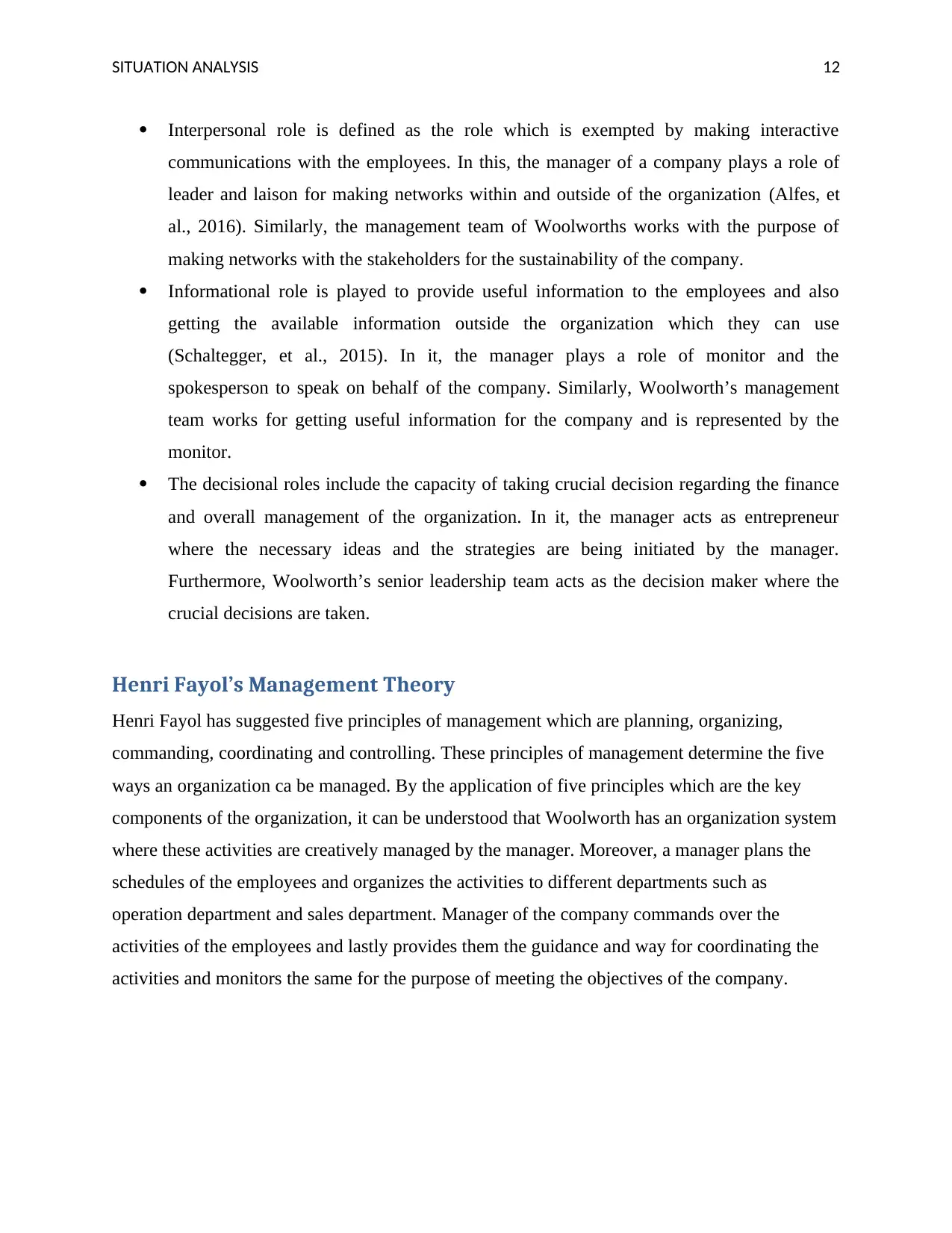
SITUATION ANALYSIS 12
Interpersonal role is defined as the role which is exempted by making interactive
communications with the employees. In this, the manager of a company plays a role of
leader and laison for making networks within and outside of the organization (Alfes, et
al., 2016). Similarly, the management team of Woolworths works with the purpose of
making networks with the stakeholders for the sustainability of the company.
Informational role is played to provide useful information to the employees and also
getting the available information outside the organization which they can use
(Schaltegger, et al., 2015). In it, the manager plays a role of monitor and the
spokesperson to speak on behalf of the company. Similarly, Woolworth’s management
team works for getting useful information for the company and is represented by the
monitor.
The decisional roles include the capacity of taking crucial decision regarding the finance
and overall management of the organization. In it, the manager acts as entrepreneur
where the necessary ideas and the strategies are being initiated by the manager.
Furthermore, Woolworth’s senior leadership team acts as the decision maker where the
crucial decisions are taken.
Henri Fayol’s Management Theory
Henri Fayol has suggested five principles of management which are planning, organizing,
commanding, coordinating and controlling. These principles of management determine the five
ways an organization ca be managed. By the application of five principles which are the key
components of the organization, it can be understood that Woolworth has an organization system
where these activities are creatively managed by the manager. Moreover, a manager plans the
schedules of the employees and organizes the activities to different departments such as
operation department and sales department. Manager of the company commands over the
activities of the employees and lastly provides them the guidance and way for coordinating the
activities and monitors the same for the purpose of meeting the objectives of the company.
Interpersonal role is defined as the role which is exempted by making interactive
communications with the employees. In this, the manager of a company plays a role of
leader and laison for making networks within and outside of the organization (Alfes, et
al., 2016). Similarly, the management team of Woolworths works with the purpose of
making networks with the stakeholders for the sustainability of the company.
Informational role is played to provide useful information to the employees and also
getting the available information outside the organization which they can use
(Schaltegger, et al., 2015). In it, the manager plays a role of monitor and the
spokesperson to speak on behalf of the company. Similarly, Woolworth’s management
team works for getting useful information for the company and is represented by the
monitor.
The decisional roles include the capacity of taking crucial decision regarding the finance
and overall management of the organization. In it, the manager acts as entrepreneur
where the necessary ideas and the strategies are being initiated by the manager.
Furthermore, Woolworth’s senior leadership team acts as the decision maker where the
crucial decisions are taken.
Henri Fayol’s Management Theory
Henri Fayol has suggested five principles of management which are planning, organizing,
commanding, coordinating and controlling. These principles of management determine the five
ways an organization ca be managed. By the application of five principles which are the key
components of the organization, it can be understood that Woolworth has an organization system
where these activities are creatively managed by the manager. Moreover, a manager plans the
schedules of the employees and organizes the activities to different departments such as
operation department and sales department. Manager of the company commands over the
activities of the employees and lastly provides them the guidance and way for coordinating the
activities and monitors the same for the purpose of meeting the objectives of the company.
Paraphrase This Document
Need a fresh take? Get an instant paraphrase of this document with our AI Paraphraser
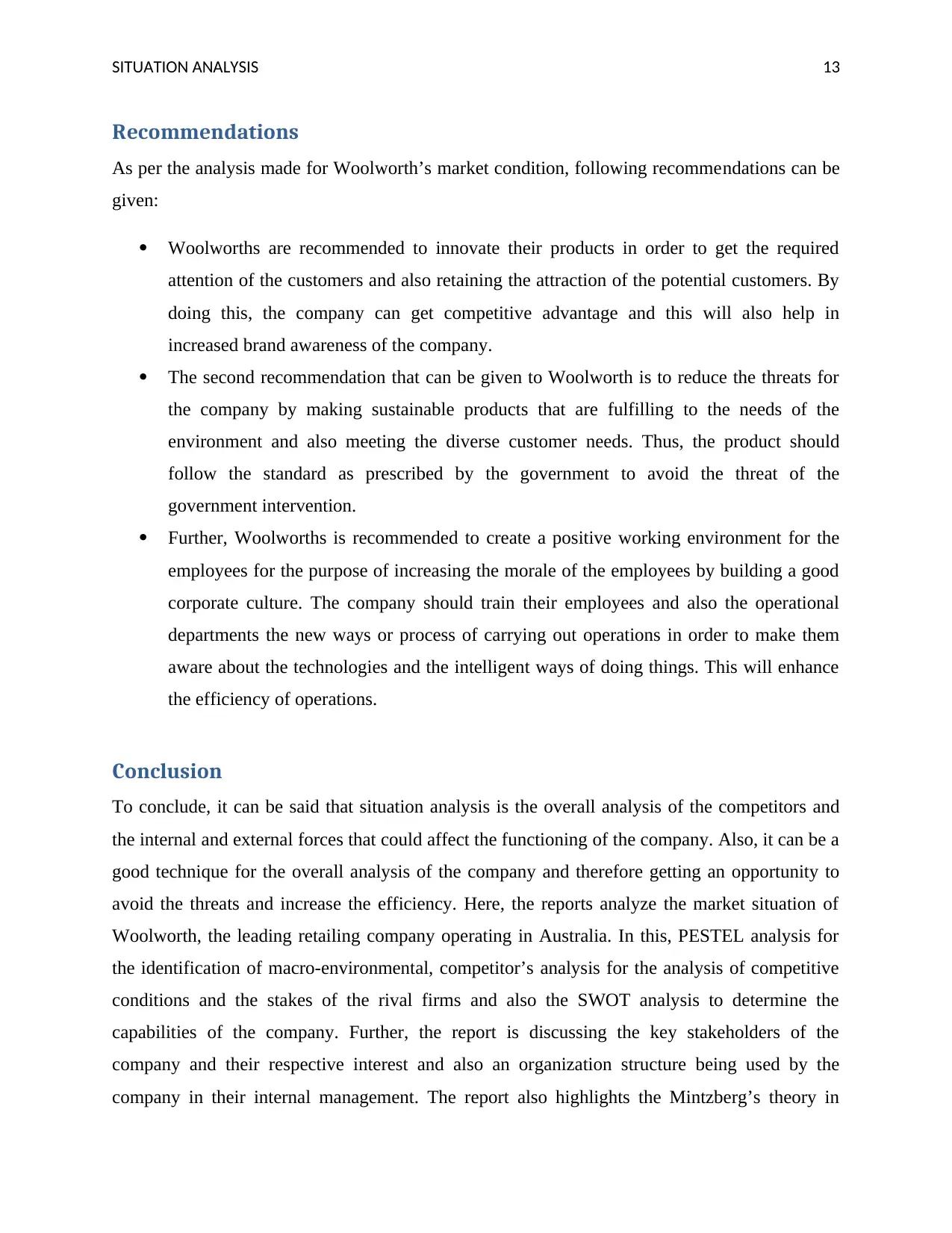
SITUATION ANALYSIS 13
Recommendations
As per the analysis made for Woolworth’s market condition, following recommendations can be
given:
Woolworths are recommended to innovate their products in order to get the required
attention of the customers and also retaining the attraction of the potential customers. By
doing this, the company can get competitive advantage and this will also help in
increased brand awareness of the company.
The second recommendation that can be given to Woolworth is to reduce the threats for
the company by making sustainable products that are fulfilling to the needs of the
environment and also meeting the diverse customer needs. Thus, the product should
follow the standard as prescribed by the government to avoid the threat of the
government intervention.
Further, Woolworths is recommended to create a positive working environment for the
employees for the purpose of increasing the morale of the employees by building a good
corporate culture. The company should train their employees and also the operational
departments the new ways or process of carrying out operations in order to make them
aware about the technologies and the intelligent ways of doing things. This will enhance
the efficiency of operations.
Conclusion
To conclude, it can be said that situation analysis is the overall analysis of the competitors and
the internal and external forces that could affect the functioning of the company. Also, it can be a
good technique for the overall analysis of the company and therefore getting an opportunity to
avoid the threats and increase the efficiency. Here, the reports analyze the market situation of
Woolworth, the leading retailing company operating in Australia. In this, PESTEL analysis for
the identification of macro-environmental, competitor’s analysis for the analysis of competitive
conditions and the stakes of the rival firms and also the SWOT analysis to determine the
capabilities of the company. Further, the report is discussing the key stakeholders of the
company and their respective interest and also an organization structure being used by the
company in their internal management. The report also highlights the Mintzberg’s theory in
Recommendations
As per the analysis made for Woolworth’s market condition, following recommendations can be
given:
Woolworths are recommended to innovate their products in order to get the required
attention of the customers and also retaining the attraction of the potential customers. By
doing this, the company can get competitive advantage and this will also help in
increased brand awareness of the company.
The second recommendation that can be given to Woolworth is to reduce the threats for
the company by making sustainable products that are fulfilling to the needs of the
environment and also meeting the diverse customer needs. Thus, the product should
follow the standard as prescribed by the government to avoid the threat of the
government intervention.
Further, Woolworths is recommended to create a positive working environment for the
employees for the purpose of increasing the morale of the employees by building a good
corporate culture. The company should train their employees and also the operational
departments the new ways or process of carrying out operations in order to make them
aware about the technologies and the intelligent ways of doing things. This will enhance
the efficiency of operations.
Conclusion
To conclude, it can be said that situation analysis is the overall analysis of the competitors and
the internal and external forces that could affect the functioning of the company. Also, it can be a
good technique for the overall analysis of the company and therefore getting an opportunity to
avoid the threats and increase the efficiency. Here, the reports analyze the market situation of
Woolworth, the leading retailing company operating in Australia. In this, PESTEL analysis for
the identification of macro-environmental, competitor’s analysis for the analysis of competitive
conditions and the stakes of the rival firms and also the SWOT analysis to determine the
capabilities of the company. Further, the report is discussing the key stakeholders of the
company and their respective interest and also an organization structure being used by the
company in their internal management. The report also highlights the Mintzberg’s theory in
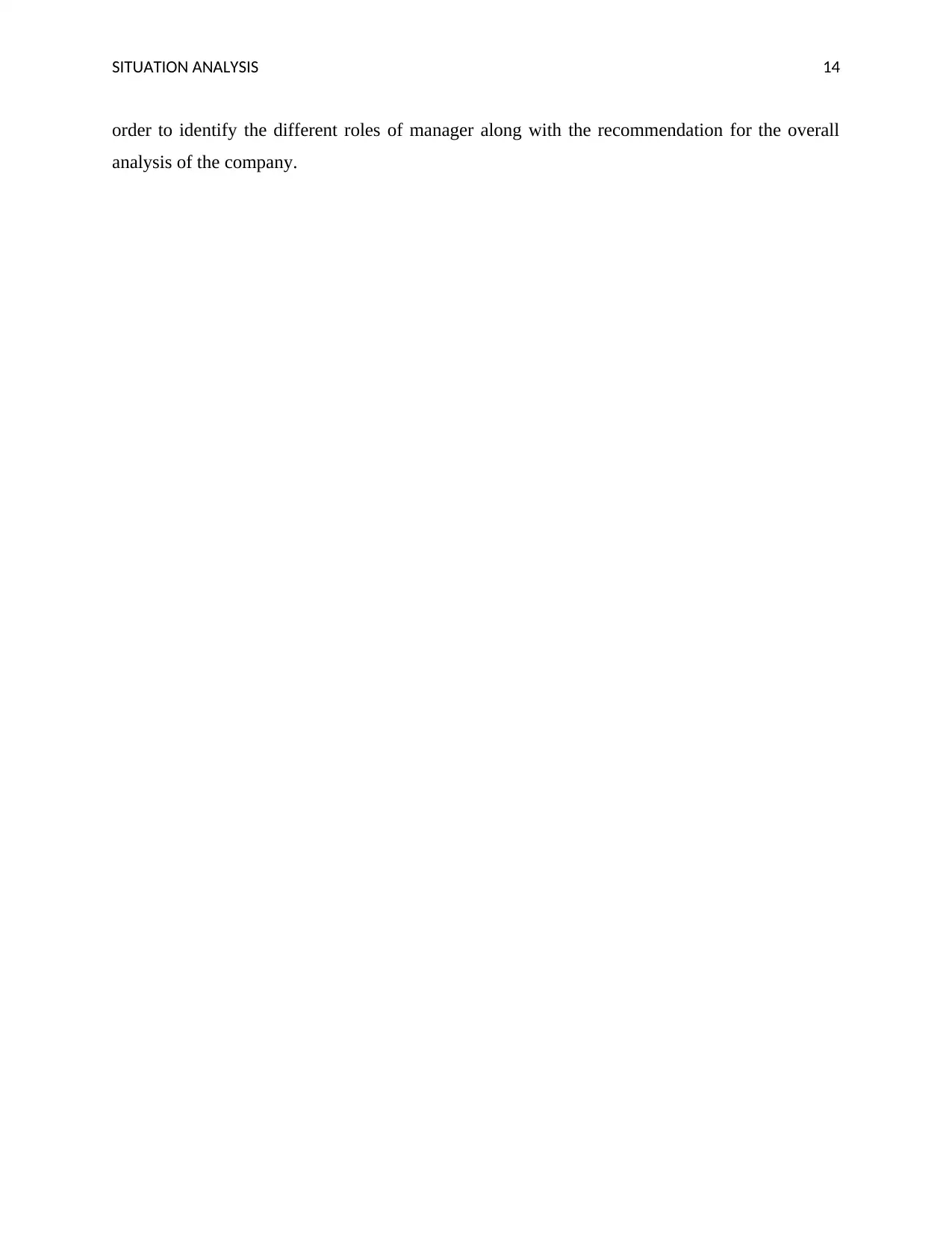
SITUATION ANALYSIS 14
order to identify the different roles of manager along with the recommendation for the overall
analysis of the company.
order to identify the different roles of manager along with the recommendation for the overall
analysis of the company.
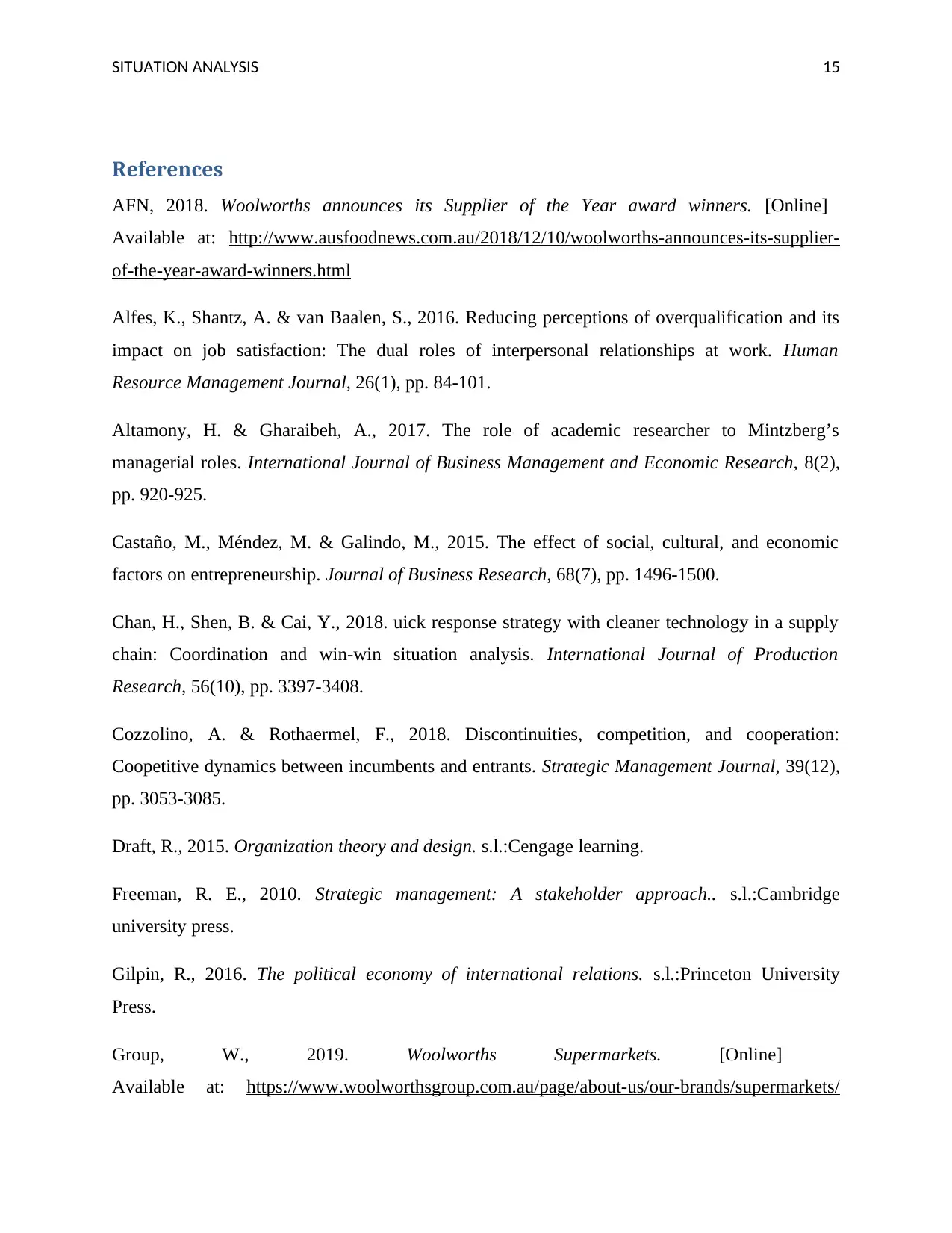
SITUATION ANALYSIS 15
References
AFN, 2018. Woolworths announces its Supplier of the Year award winners. [Online]
Available at: http://www.ausfoodnews.com.au/2018/12/10/woolworths-announces-its-supplier-
of-the-year-award-winners.html
Alfes, K., Shantz, A. & van Baalen, S., 2016. Reducing perceptions of overqualification and its
impact on job satisfaction: The dual roles of interpersonal relationships at work. Human
Resource Management Journal, 26(1), pp. 84-101.
Altamony, H. & Gharaibeh, A., 2017. The role of academic researcher to Mintzberg’s
managerial roles. International Journal of Business Management and Economic Research, 8(2),
pp. 920-925.
Castaño, M., Méndez, M. & Galindo, M., 2015. The effect of social, cultural, and economic
factors on entrepreneurship. Journal of Business Research, 68(7), pp. 1496-1500.
Chan, H., Shen, B. & Cai, Y., 2018. uick response strategy with cleaner technology in a supply
chain: Coordination and win-win situation analysis. International Journal of Production
Research, 56(10), pp. 3397-3408.
Cozzolino, A. & Rothaermel, F., 2018. Discontinuities, competition, and cooperation:
Coopetitive dynamics between incumbents and entrants. Strategic Management Journal, 39(12),
pp. 3053-3085.
Draft, R., 2015. Organization theory and design. s.l.:Cengage learning.
Freeman, R. E., 2010. Strategic management: A stakeholder approach.. s.l.:Cambridge
university press.
Gilpin, R., 2016. The political economy of international relations. s.l.:Princeton University
Press.
Group, W., 2019. Woolworths Supermarkets. [Online]
Available at: https://www.woolworthsgroup.com.au/page/about-us/our-brands/supermarkets/
References
AFN, 2018. Woolworths announces its Supplier of the Year award winners. [Online]
Available at: http://www.ausfoodnews.com.au/2018/12/10/woolworths-announces-its-supplier-
of-the-year-award-winners.html
Alfes, K., Shantz, A. & van Baalen, S., 2016. Reducing perceptions of overqualification and its
impact on job satisfaction: The dual roles of interpersonal relationships at work. Human
Resource Management Journal, 26(1), pp. 84-101.
Altamony, H. & Gharaibeh, A., 2017. The role of academic researcher to Mintzberg’s
managerial roles. International Journal of Business Management and Economic Research, 8(2),
pp. 920-925.
Castaño, M., Méndez, M. & Galindo, M., 2015. The effect of social, cultural, and economic
factors on entrepreneurship. Journal of Business Research, 68(7), pp. 1496-1500.
Chan, H., Shen, B. & Cai, Y., 2018. uick response strategy with cleaner technology in a supply
chain: Coordination and win-win situation analysis. International Journal of Production
Research, 56(10), pp. 3397-3408.
Cozzolino, A. & Rothaermel, F., 2018. Discontinuities, competition, and cooperation:
Coopetitive dynamics between incumbents and entrants. Strategic Management Journal, 39(12),
pp. 3053-3085.
Draft, R., 2015. Organization theory and design. s.l.:Cengage learning.
Freeman, R. E., 2010. Strategic management: A stakeholder approach.. s.l.:Cambridge
university press.
Gilpin, R., 2016. The political economy of international relations. s.l.:Princeton University
Press.
Group, W., 2019. Woolworths Supermarkets. [Online]
Available at: https://www.woolworthsgroup.com.au/page/about-us/our-brands/supermarkets/
Secure Best Marks with AI Grader
Need help grading? Try our AI Grader for instant feedback on your assignments.
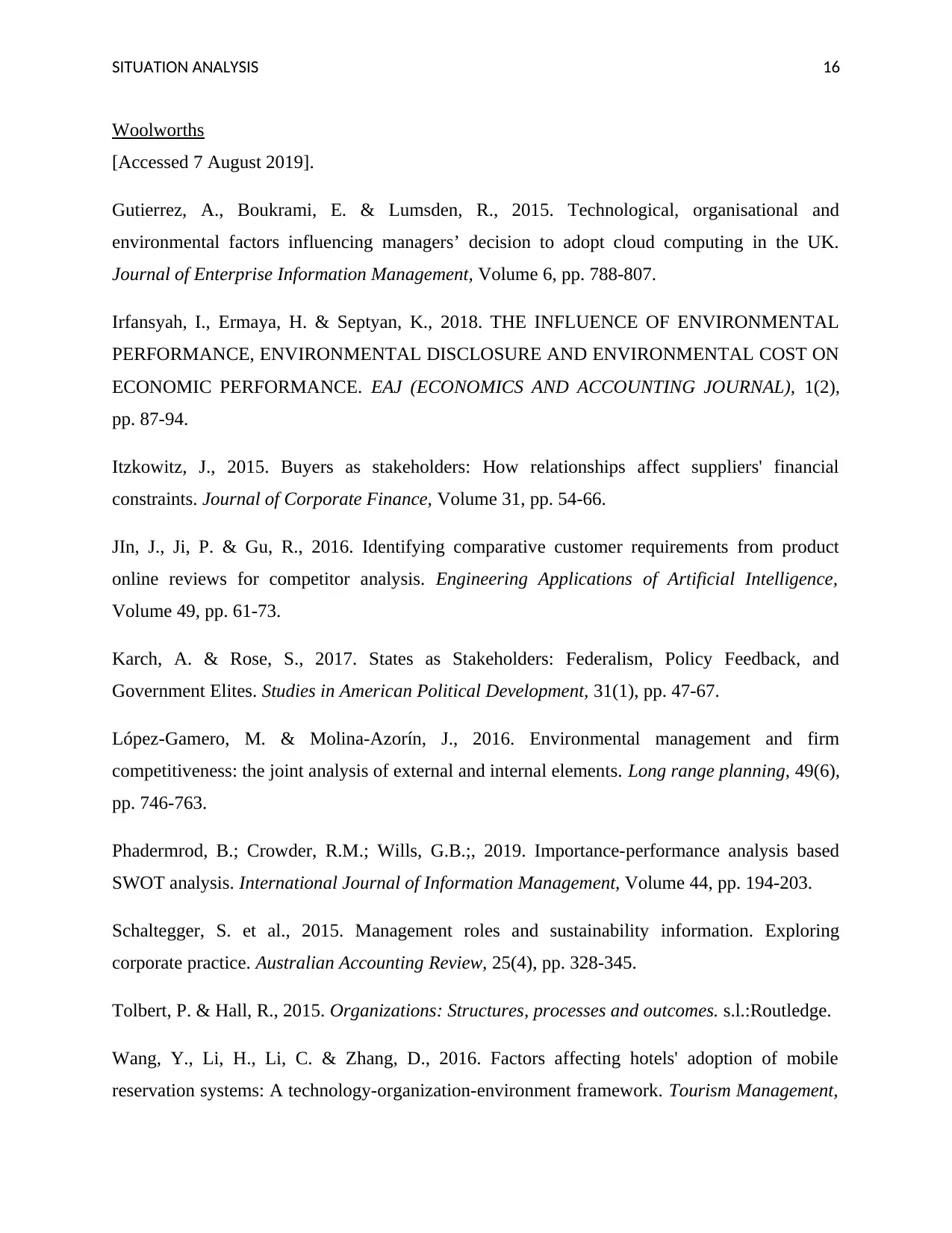
SITUATION ANALYSIS 16
Woolworths
[Accessed 7 August 2019].
Gutierrez, A., Boukrami, E. & Lumsden, R., 2015. Technological, organisational and
environmental factors influencing managers’ decision to adopt cloud computing in the UK.
Journal of Enterprise Information Management, Volume 6, pp. 788-807.
Irfansyah, I., Ermaya, H. & Septyan, K., 2018. THE INFLUENCE OF ENVIRONMENTAL
PERFORMANCE, ENVIRONMENTAL DISCLOSURE AND ENVIRONMENTAL COST ON
ECONOMIC PERFORMANCE. EAJ (ECONOMICS AND ACCOUNTING JOURNAL), 1(2),
pp. 87-94.
Itzkowitz, J., 2015. Buyers as stakeholders: How relationships affect suppliers' financial
constraints. Journal of Corporate Finance, Volume 31, pp. 54-66.
JIn, J., Ji, P. & Gu, R., 2016. Identifying comparative customer requirements from product
online reviews for competitor analysis. Engineering Applications of Artificial Intelligence,
Volume 49, pp. 61-73.
Karch, A. & Rose, S., 2017. States as Stakeholders: Federalism, Policy Feedback, and
Government Elites. Studies in American Political Development, 31(1), pp. 47-67.
López-Gamero, M. & Molina-Azorín, J., 2016. Environmental management and firm
competitiveness: the joint analysis of external and internal elements. Long range planning, 49(6),
pp. 746-763.
Phadermrod, B.; Crowder, R.M.; Wills, G.B.;, 2019. Importance-performance analysis based
SWOT analysis. International Journal of Information Management, Volume 44, pp. 194-203.
Schaltegger, S. et al., 2015. Management roles and sustainability information. Exploring
corporate practice. Australian Accounting Review, 25(4), pp. 328-345.
Tolbert, P. & Hall, R., 2015. Organizations: Structures, processes and outcomes. s.l.:Routledge.
Wang, Y., Li, H., Li, C. & Zhang, D., 2016. Factors affecting hotels' adoption of mobile
reservation systems: A technology-organization-environment framework. Tourism Management,
Woolworths
[Accessed 7 August 2019].
Gutierrez, A., Boukrami, E. & Lumsden, R., 2015. Technological, organisational and
environmental factors influencing managers’ decision to adopt cloud computing in the UK.
Journal of Enterprise Information Management, Volume 6, pp. 788-807.
Irfansyah, I., Ermaya, H. & Septyan, K., 2018. THE INFLUENCE OF ENVIRONMENTAL
PERFORMANCE, ENVIRONMENTAL DISCLOSURE AND ENVIRONMENTAL COST ON
ECONOMIC PERFORMANCE. EAJ (ECONOMICS AND ACCOUNTING JOURNAL), 1(2),
pp. 87-94.
Itzkowitz, J., 2015. Buyers as stakeholders: How relationships affect suppliers' financial
constraints. Journal of Corporate Finance, Volume 31, pp. 54-66.
JIn, J., Ji, P. & Gu, R., 2016. Identifying comparative customer requirements from product
online reviews for competitor analysis. Engineering Applications of Artificial Intelligence,
Volume 49, pp. 61-73.
Karch, A. & Rose, S., 2017. States as Stakeholders: Federalism, Policy Feedback, and
Government Elites. Studies in American Political Development, 31(1), pp. 47-67.
López-Gamero, M. & Molina-Azorín, J., 2016. Environmental management and firm
competitiveness: the joint analysis of external and internal elements. Long range planning, 49(6),
pp. 746-763.
Phadermrod, B.; Crowder, R.M.; Wills, G.B.;, 2019. Importance-performance analysis based
SWOT analysis. International Journal of Information Management, Volume 44, pp. 194-203.
Schaltegger, S. et al., 2015. Management roles and sustainability information. Exploring
corporate practice. Australian Accounting Review, 25(4), pp. 328-345.
Tolbert, P. & Hall, R., 2015. Organizations: Structures, processes and outcomes. s.l.:Routledge.
Wang, Y., Li, H., Li, C. & Zhang, D., 2016. Factors affecting hotels' adoption of mobile
reservation systems: A technology-organization-environment framework. Tourism Management,
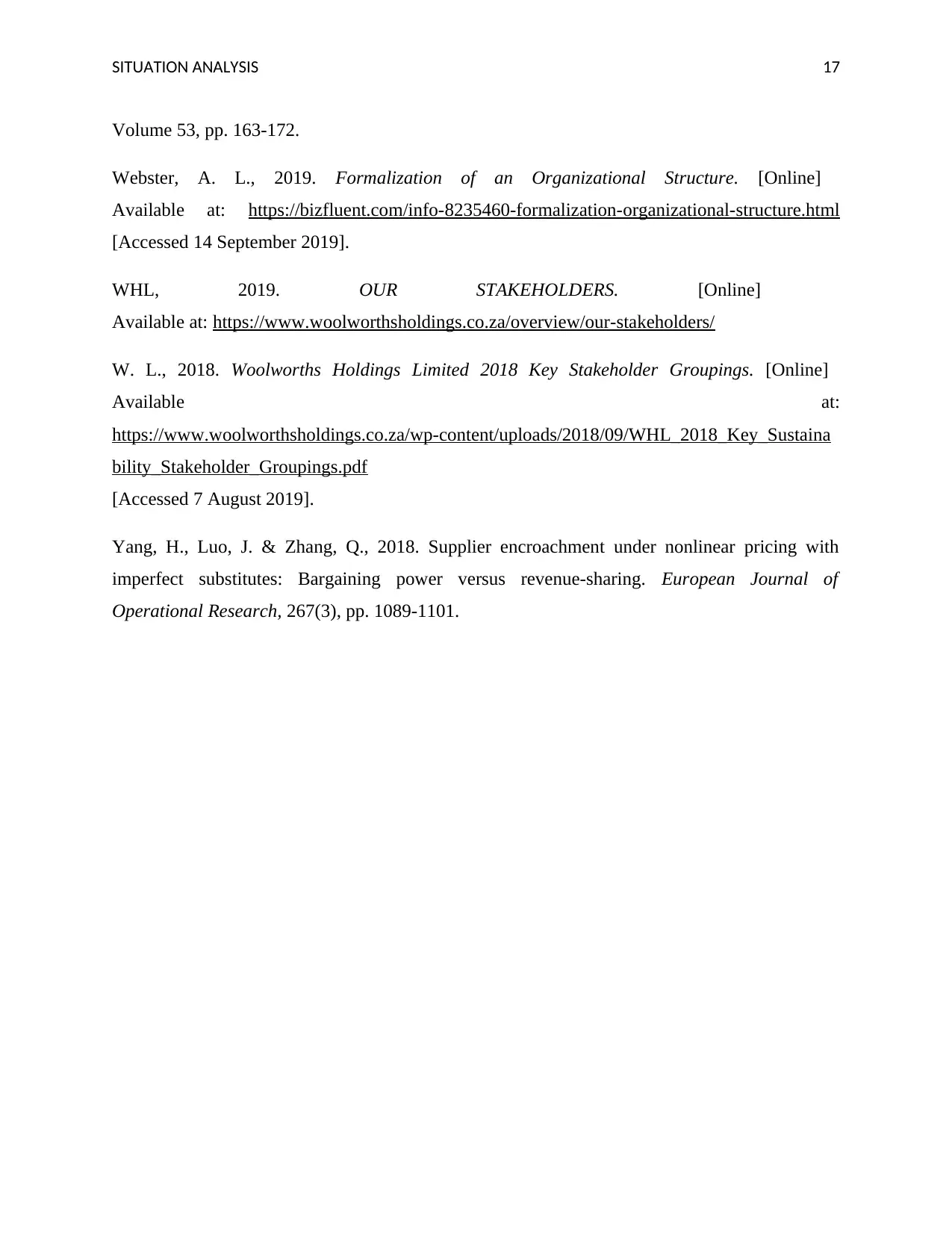
SITUATION ANALYSIS 17
Volume 53, pp. 163-172.
Webster, A. L., 2019. Formalization of an Organizational Structure. [Online]
Available at: https://bizfluent.com/info-8235460-formalization-organizational-structure.html
[Accessed 14 September 2019].
WHL, 2019. OUR STAKEHOLDERS. [Online]
Available at: https://www.woolworthsholdings.co.za/overview/our-stakeholders/
W. L., 2018. Woolworths Holdings Limited 2018 Key Stakeholder Groupings. [Online]
Available at:
https://www.woolworthsholdings.co.za/wp-content/uploads/2018/09/WHL_2018_Key_Sustaina
bility_Stakeholder_Groupings.pdf
[Accessed 7 August 2019].
Yang, H., Luo, J. & Zhang, Q., 2018. Supplier encroachment under nonlinear pricing with
imperfect substitutes: Bargaining power versus revenue-sharing. European Journal of
Operational Research, 267(3), pp. 1089-1101.
Volume 53, pp. 163-172.
Webster, A. L., 2019. Formalization of an Organizational Structure. [Online]
Available at: https://bizfluent.com/info-8235460-formalization-organizational-structure.html
[Accessed 14 September 2019].
WHL, 2019. OUR STAKEHOLDERS. [Online]
Available at: https://www.woolworthsholdings.co.za/overview/our-stakeholders/
W. L., 2018. Woolworths Holdings Limited 2018 Key Stakeholder Groupings. [Online]
Available at:
https://www.woolworthsholdings.co.za/wp-content/uploads/2018/09/WHL_2018_Key_Sustaina
bility_Stakeholder_Groupings.pdf
[Accessed 7 August 2019].
Yang, H., Luo, J. & Zhang, Q., 2018. Supplier encroachment under nonlinear pricing with
imperfect substitutes: Bargaining power versus revenue-sharing. European Journal of
Operational Research, 267(3), pp. 1089-1101.
1 out of 18
Related Documents
Your All-in-One AI-Powered Toolkit for Academic Success.
+13062052269
info@desklib.com
Available 24*7 on WhatsApp / Email
![[object Object]](/_next/static/media/star-bottom.7253800d.svg)
Unlock your academic potential
© 2024 | Zucol Services PVT LTD | All rights reserved.




